Financial Statement Analysis and Reporting
VerifiedAdded on 2021/04/21
|30
|2825
|142
AI Summary
This assignment delves into the world of financial accounting, focusing on the significance of financial statement analysis, and the preparation of various financial reports such as trial balance, income statements, balance sheets, and changes in equity. It also touches upon current ratio calculations and highlights the importance of these reports for decision-making and accountability. The document includes references to relevant studies and publications in the field of accounting.
Contribute Materials
Your contribution can guide someone’s learning journey. Share your
documents today.
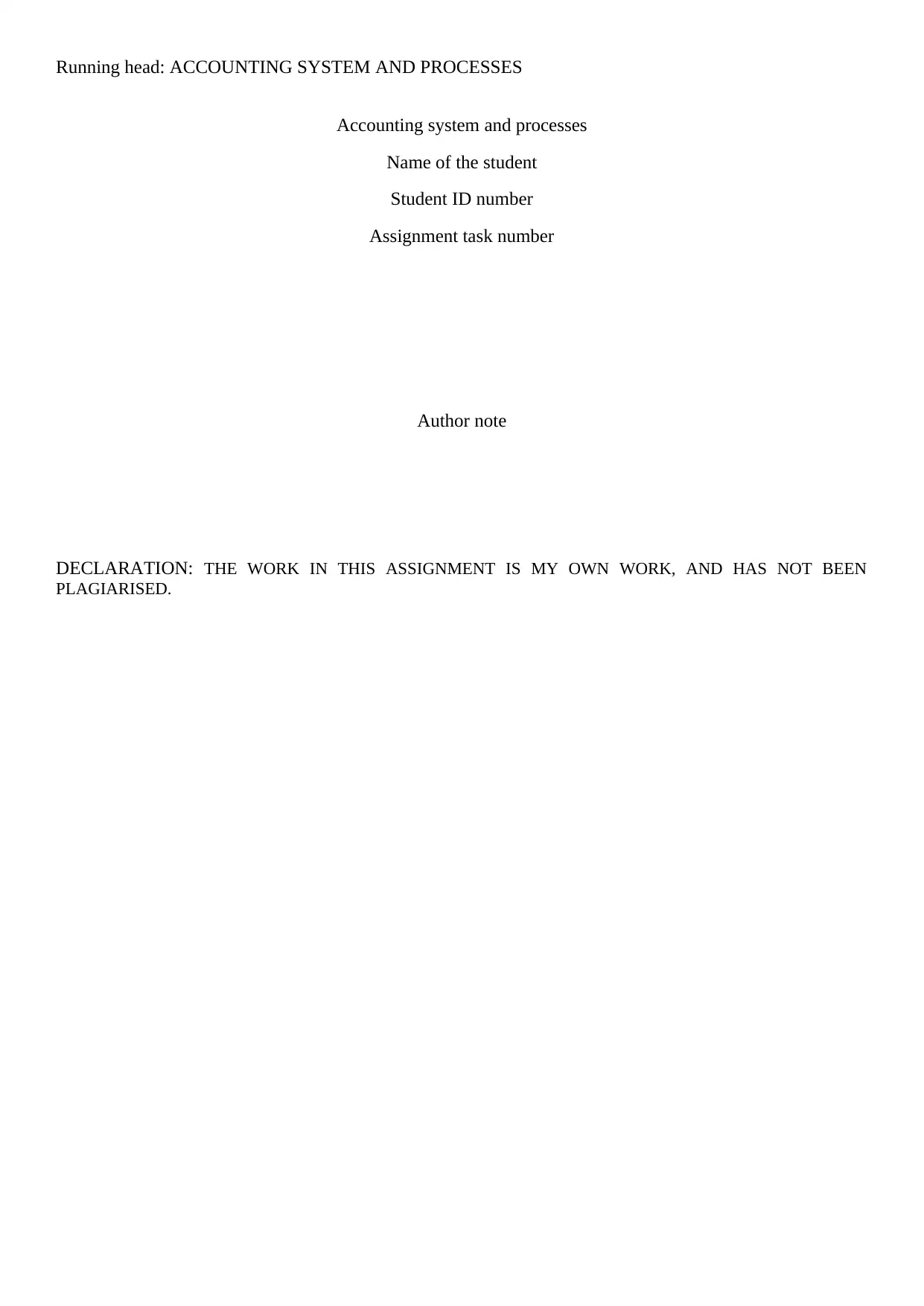
Running head: ACCOUNTING SYSTEM AND PROCESSES
Accounting system and processes
Name of the student
Student ID number
Assignment task number
Author note
DECLARATION: THE WORK IN THIS ASSIGNMENT IS MY OWN WORK, AND HAS NOT BEEN
PLAGIARISED.
Accounting system and processes
Name of the student
Student ID number
Assignment task number
Author note
DECLARATION: THE WORK IN THIS ASSIGNMENT IS MY OWN WORK, AND HAS NOT BEEN
PLAGIARISED.
Secure Best Marks with AI Grader
Need help grading? Try our AI Grader for instant feedback on your assignments.

ACCOUNTING SYSTEM AND PROCESSES
Table of Contents
1. Plagiarism:..................................................................................................................................................2
2. Pasting spreadsheets in the doc files:..........................................................................................................2
3. Accounting resources on the internet:........................................................................................................4
4. Professional accounting bodies:..................................................................................................................4
5. Work integrated assessment:......................................................................................................................4
6. Business report:...........................................................................................................................................5
7. P A L E R:...................................................................................................................................................5
8. Balance sheet equation................................................................................................................................6
9. Debit and credit balance:............................................................................................................................7
10. Trial balance............................................................................................................................................7
11. Crossword.............................................................................................................................................12
12. Adjusting entries...................................................................................................................................13
13. Current and non-current liabilities........................................................................................................14
14. Ratios.....................................................................................................................................................14
15. Worksheets and financial reports..........................................................................................................14
References:.......................................................................................................................................................24
1
Student Name
Student ID number
Table of Contents
1. Plagiarism:..................................................................................................................................................2
2. Pasting spreadsheets in the doc files:..........................................................................................................2
3. Accounting resources on the internet:........................................................................................................4
4. Professional accounting bodies:..................................................................................................................4
5. Work integrated assessment:......................................................................................................................4
6. Business report:...........................................................................................................................................5
7. P A L E R:...................................................................................................................................................5
8. Balance sheet equation................................................................................................................................6
9. Debit and credit balance:............................................................................................................................7
10. Trial balance............................................................................................................................................7
11. Crossword.............................................................................................................................................12
12. Adjusting entries...................................................................................................................................13
13. Current and non-current liabilities........................................................................................................14
14. Ratios.....................................................................................................................................................14
15. Worksheets and financial reports..........................................................................................................14
References:.......................................................................................................................................................24
1
Student Name
Student ID number

ACCOUNTING SYSTEM AND PROCESSES
1. Plagiarism:
Plagiarism takes place when the writer duplicates the ideas or language of another student and
presents the work as his own. All unpublished and published material; whether in electronic or printed form
is covered under the definition. Collusion takes place when more than 1 student has taken part in completing
the assignment and is submitted as individual’s work subsequently (Ferro & Martins, 2016). Therefore,
collusion will also be considered as plagiarism. This is unfair to the honest students as the honest student
who has submitted his task on his own may get lower marks as compared to the student who has copied
someone else’s work.
2. Pasting spreadsheets in the doc files:
Normal view:
2
Student Name
Student ID number
1. Plagiarism:
Plagiarism takes place when the writer duplicates the ideas or language of another student and
presents the work as his own. All unpublished and published material; whether in electronic or printed form
is covered under the definition. Collusion takes place when more than 1 student has taken part in completing
the assignment and is submitted as individual’s work subsequently (Ferro & Martins, 2016). Therefore,
collusion will also be considered as plagiarism. This is unfair to the honest students as the honest student
who has submitted his task on his own may get lower marks as compared to the student who has copied
someone else’s work.
2. Pasting spreadsheets in the doc files:
Normal view:
2
Student Name
Student ID number
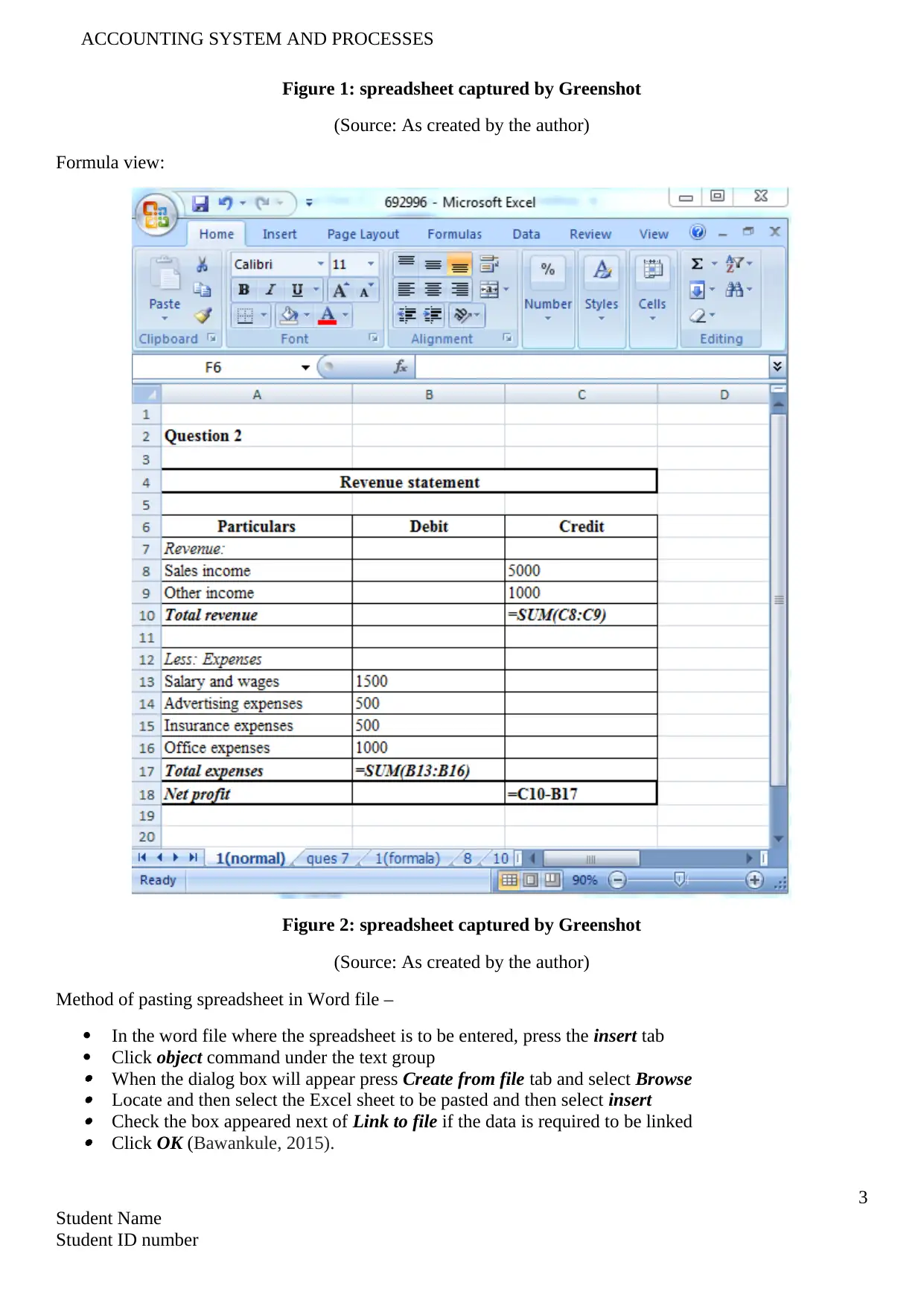
ACCOUNTING SYSTEM AND PROCESSES
Figure 1: spreadsheet captured by Greenshot
(Source: As created by the author)
Formula view:
Figure 2: spreadsheet captured by Greenshot
(Source: As created by the author)
Method of pasting spreadsheet in Word file –
In the word file where the spreadsheet is to be entered, press the insert tab
Click object command under the text group When the dialog box will appear press Create from file tab and select Browse Locate and then select the Excel sheet to be pasted and then select insert Check the box appeared next of Link to file if the data is required to be linked Click OK (Bawankule, 2015).
3
Student Name
Student ID number
Figure 1: spreadsheet captured by Greenshot
(Source: As created by the author)
Formula view:
Figure 2: spreadsheet captured by Greenshot
(Source: As created by the author)
Method of pasting spreadsheet in Word file –
In the word file where the spreadsheet is to be entered, press the insert tab
Click object command under the text group When the dialog box will appear press Create from file tab and select Browse Locate and then select the Excel sheet to be pasted and then select insert Check the box appeared next of Link to file if the data is required to be linked Click OK (Bawankule, 2015).
3
Student Name
Student ID number
Secure Best Marks with AI Grader
Need help grading? Try our AI Grader for instant feedback on your assignments.
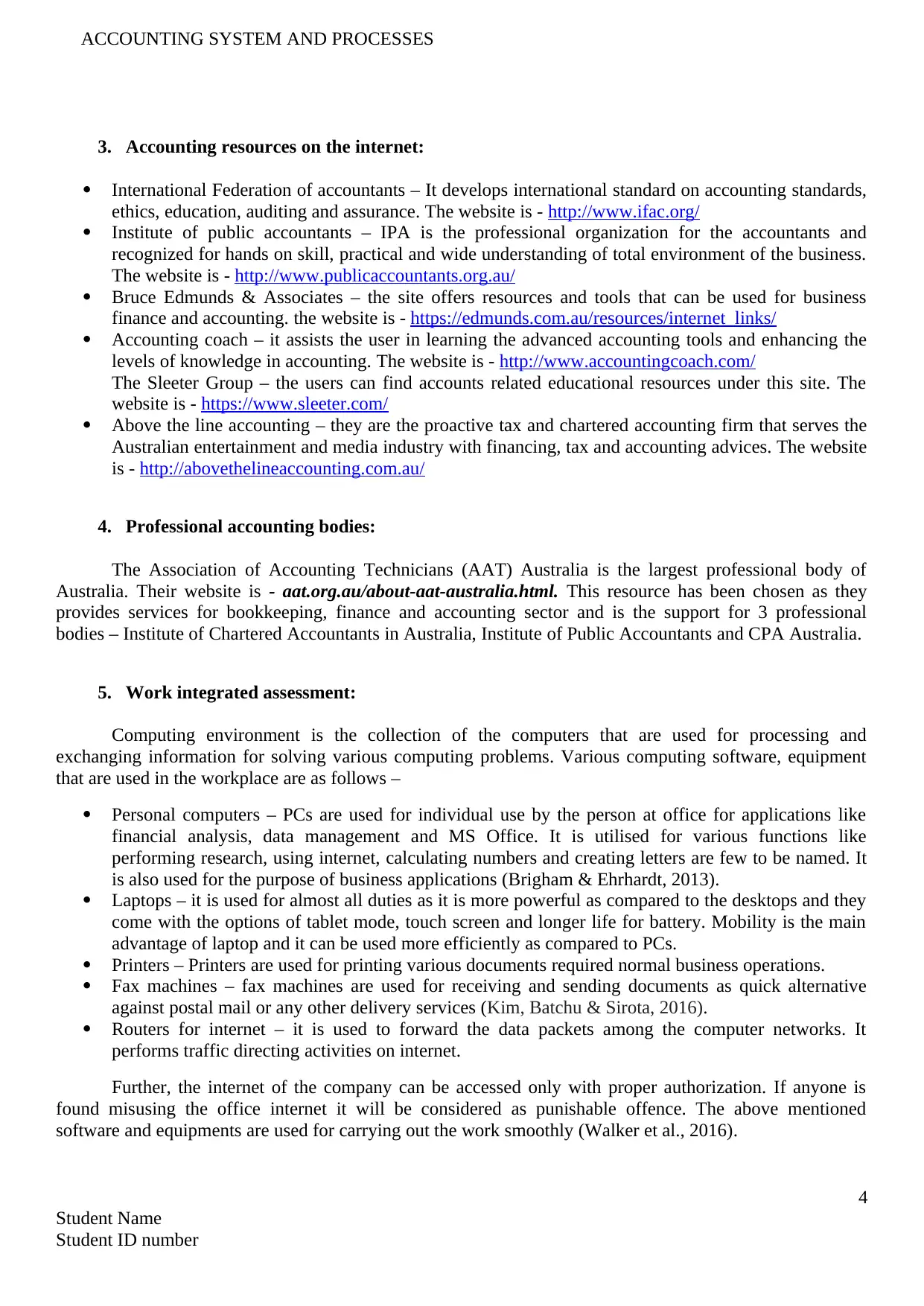
ACCOUNTING SYSTEM AND PROCESSES
3. Accounting resources on the internet:
International Federation of accountants – It develops international standard on accounting standards,
ethics, education, auditing and assurance. The website is - http://www.ifac.org/
Institute of public accountants – IPA is the professional organization for the accountants and
recognized for hands on skill, practical and wide understanding of total environment of the business.
The website is - http://www.publicaccountants.org.au/
Bruce Edmunds & Associates – the site offers resources and tools that can be used for business
finance and accounting. the website is - https://edmunds.com.au/resources/internet_links/
Accounting coach – it assists the user in learning the advanced accounting tools and enhancing the
levels of knowledge in accounting. The website is - http://www.accountingcoach.com/
The Sleeter Group – the users can find accounts related educational resources under this site. The
website is - https://www.sleeter.com/
Above the line accounting – they are the proactive tax and chartered accounting firm that serves the
Australian entertainment and media industry with financing, tax and accounting advices. The website
is - http://abovethelineaccounting.com.au/
4. Professional accounting bodies:
The Association of Accounting Technicians (AAT) Australia is the largest professional body of
Australia. Their website is - aat.org.au/about-aat-australia.html. This resource has been chosen as they
provides services for bookkeeping, finance and accounting sector and is the support for 3 professional
bodies – Institute of Chartered Accountants in Australia, Institute of Public Accountants and CPA Australia.
5. Work integrated assessment:
Computing environment is the collection of the computers that are used for processing and
exchanging information for solving various computing problems. Various computing software, equipment
that are used in the workplace are as follows –
Personal computers – PCs are used for individual use by the person at office for applications like
financial analysis, data management and MS Office. It is utilised for various functions like
performing research, using internet, calculating numbers and creating letters are few to be named. It
is also used for the purpose of business applications (Brigham & Ehrhardt, 2013).
Laptops – it is used for almost all duties as it is more powerful as compared to the desktops and they
come with the options of tablet mode, touch screen and longer life for battery. Mobility is the main
advantage of laptop and it can be used more efficiently as compared to PCs.
Printers – Printers are used for printing various documents required normal business operations.
Fax machines – fax machines are used for receiving and sending documents as quick alternative
against postal mail or any other delivery services (Kim, Batchu & Sirota, 2016).
Routers for internet – it is used to forward the data packets among the computer networks. It
performs traffic directing activities on internet.
Further, the internet of the company can be accessed only with proper authorization. If anyone is
found misusing the office internet it will be considered as punishable offence. The above mentioned
software and equipments are used for carrying out the work smoothly (Walker et al., 2016).
4
Student Name
Student ID number
3. Accounting resources on the internet:
International Federation of accountants – It develops international standard on accounting standards,
ethics, education, auditing and assurance. The website is - http://www.ifac.org/
Institute of public accountants – IPA is the professional organization for the accountants and
recognized for hands on skill, practical and wide understanding of total environment of the business.
The website is - http://www.publicaccountants.org.au/
Bruce Edmunds & Associates – the site offers resources and tools that can be used for business
finance and accounting. the website is - https://edmunds.com.au/resources/internet_links/
Accounting coach – it assists the user in learning the advanced accounting tools and enhancing the
levels of knowledge in accounting. The website is - http://www.accountingcoach.com/
The Sleeter Group – the users can find accounts related educational resources under this site. The
website is - https://www.sleeter.com/
Above the line accounting – they are the proactive tax and chartered accounting firm that serves the
Australian entertainment and media industry with financing, tax and accounting advices. The website
is - http://abovethelineaccounting.com.au/
4. Professional accounting bodies:
The Association of Accounting Technicians (AAT) Australia is the largest professional body of
Australia. Their website is - aat.org.au/about-aat-australia.html. This resource has been chosen as they
provides services for bookkeeping, finance and accounting sector and is the support for 3 professional
bodies – Institute of Chartered Accountants in Australia, Institute of Public Accountants and CPA Australia.
5. Work integrated assessment:
Computing environment is the collection of the computers that are used for processing and
exchanging information for solving various computing problems. Various computing software, equipment
that are used in the workplace are as follows –
Personal computers – PCs are used for individual use by the person at office for applications like
financial analysis, data management and MS Office. It is utilised for various functions like
performing research, using internet, calculating numbers and creating letters are few to be named. It
is also used for the purpose of business applications (Brigham & Ehrhardt, 2013).
Laptops – it is used for almost all duties as it is more powerful as compared to the desktops and they
come with the options of tablet mode, touch screen and longer life for battery. Mobility is the main
advantage of laptop and it can be used more efficiently as compared to PCs.
Printers – Printers are used for printing various documents required normal business operations.
Fax machines – fax machines are used for receiving and sending documents as quick alternative
against postal mail or any other delivery services (Kim, Batchu & Sirota, 2016).
Routers for internet – it is used to forward the data packets among the computer networks. It
performs traffic directing activities on internet.
Further, the internet of the company can be accessed only with proper authorization. If anyone is
found misusing the office internet it will be considered as punishable offence. The above mentioned
software and equipments are used for carrying out the work smoothly (Walker et al., 2016).
4
Student Name
Student ID number
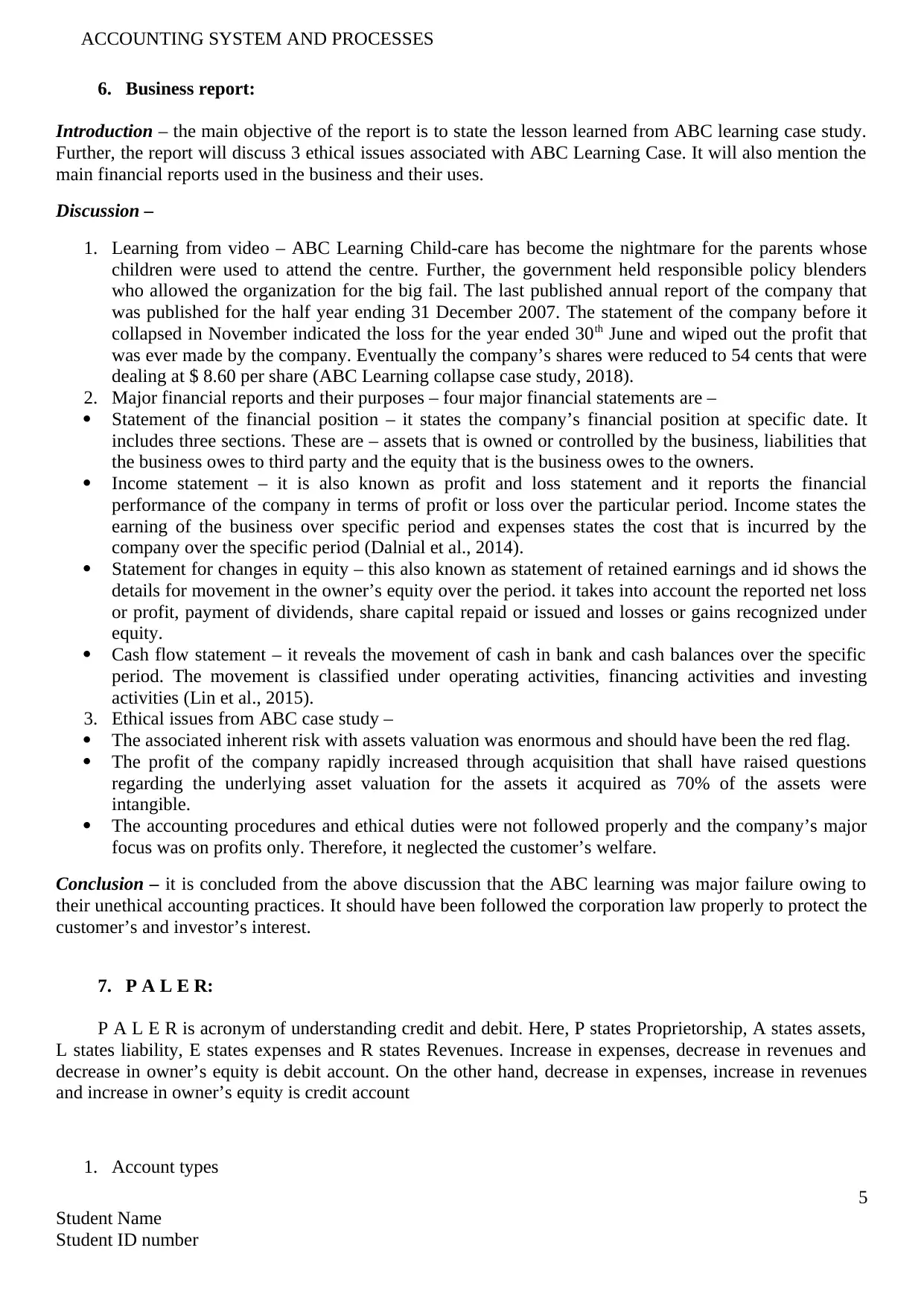
ACCOUNTING SYSTEM AND PROCESSES
6. Business report:
Introduction – the main objective of the report is to state the lesson learned from ABC learning case study.
Further, the report will discuss 3 ethical issues associated with ABC Learning Case. It will also mention the
main financial reports used in the business and their uses.
Discussion –
1. Learning from video – ABC Learning Child-care has become the nightmare for the parents whose
children were used to attend the centre. Further, the government held responsible policy blenders
who allowed the organization for the big fail. The last published annual report of the company that
was published for the half year ending 31 December 2007. The statement of the company before it
collapsed in November indicated the loss for the year ended 30th June and wiped out the profit that
was ever made by the company. Eventually the company’s shares were reduced to 54 cents that were
dealing at $ 8.60 per share (ABC Learning collapse case study, 2018).
2. Major financial reports and their purposes – four major financial statements are –
Statement of the financial position – it states the company’s financial position at specific date. It
includes three sections. These are – assets that is owned or controlled by the business, liabilities that
the business owes to third party and the equity that is the business owes to the owners.
Income statement – it is also known as profit and loss statement and it reports the financial
performance of the company in terms of profit or loss over the particular period. Income states the
earning of the business over specific period and expenses states the cost that is incurred by the
company over the specific period (Dalnial et al., 2014).
Statement for changes in equity – this also known as statement of retained earnings and id shows the
details for movement in the owner’s equity over the period. it takes into account the reported net loss
or profit, payment of dividends, share capital repaid or issued and losses or gains recognized under
equity.
Cash flow statement – it reveals the movement of cash in bank and cash balances over the specific
period. The movement is classified under operating activities, financing activities and investing
activities (Lin et al., 2015).
3. Ethical issues from ABC case study –
The associated inherent risk with assets valuation was enormous and should have been the red flag.
The profit of the company rapidly increased through acquisition that shall have raised questions
regarding the underlying asset valuation for the assets it acquired as 70% of the assets were
intangible.
The accounting procedures and ethical duties were not followed properly and the company’s major
focus was on profits only. Therefore, it neglected the customer’s welfare.
Conclusion – it is concluded from the above discussion that the ABC learning was major failure owing to
their unethical accounting practices. It should have been followed the corporation law properly to protect the
customer’s and investor’s interest.
7. P A L E R:
P A L E R is acronym of understanding credit and debit. Here, P states Proprietorship, A states assets,
L states liability, E states expenses and R states Revenues. Increase in expenses, decrease in revenues and
decrease in owner’s equity is debit account. On the other hand, decrease in expenses, increase in revenues
and increase in owner’s equity is credit account
1. Account types
5
Student Name
Student ID number
6. Business report:
Introduction – the main objective of the report is to state the lesson learned from ABC learning case study.
Further, the report will discuss 3 ethical issues associated with ABC Learning Case. It will also mention the
main financial reports used in the business and their uses.
Discussion –
1. Learning from video – ABC Learning Child-care has become the nightmare for the parents whose
children were used to attend the centre. Further, the government held responsible policy blenders
who allowed the organization for the big fail. The last published annual report of the company that
was published for the half year ending 31 December 2007. The statement of the company before it
collapsed in November indicated the loss for the year ended 30th June and wiped out the profit that
was ever made by the company. Eventually the company’s shares were reduced to 54 cents that were
dealing at $ 8.60 per share (ABC Learning collapse case study, 2018).
2. Major financial reports and their purposes – four major financial statements are –
Statement of the financial position – it states the company’s financial position at specific date. It
includes three sections. These are – assets that is owned or controlled by the business, liabilities that
the business owes to third party and the equity that is the business owes to the owners.
Income statement – it is also known as profit and loss statement and it reports the financial
performance of the company in terms of profit or loss over the particular period. Income states the
earning of the business over specific period and expenses states the cost that is incurred by the
company over the specific period (Dalnial et al., 2014).
Statement for changes in equity – this also known as statement of retained earnings and id shows the
details for movement in the owner’s equity over the period. it takes into account the reported net loss
or profit, payment of dividends, share capital repaid or issued and losses or gains recognized under
equity.
Cash flow statement – it reveals the movement of cash in bank and cash balances over the specific
period. The movement is classified under operating activities, financing activities and investing
activities (Lin et al., 2015).
3. Ethical issues from ABC case study –
The associated inherent risk with assets valuation was enormous and should have been the red flag.
The profit of the company rapidly increased through acquisition that shall have raised questions
regarding the underlying asset valuation for the assets it acquired as 70% of the assets were
intangible.
The accounting procedures and ethical duties were not followed properly and the company’s major
focus was on profits only. Therefore, it neglected the customer’s welfare.
Conclusion – it is concluded from the above discussion that the ABC learning was major failure owing to
their unethical accounting practices. It should have been followed the corporation law properly to protect the
customer’s and investor’s interest.
7. P A L E R:
P A L E R is acronym of understanding credit and debit. Here, P states Proprietorship, A states assets,
L states liability, E states expenses and R states Revenues. Increase in expenses, decrease in revenues and
decrease in owner’s equity is debit account. On the other hand, decrease in expenses, increase in revenues
and increase in owner’s equity is credit account
1. Account types
5
Student Name
Student ID number
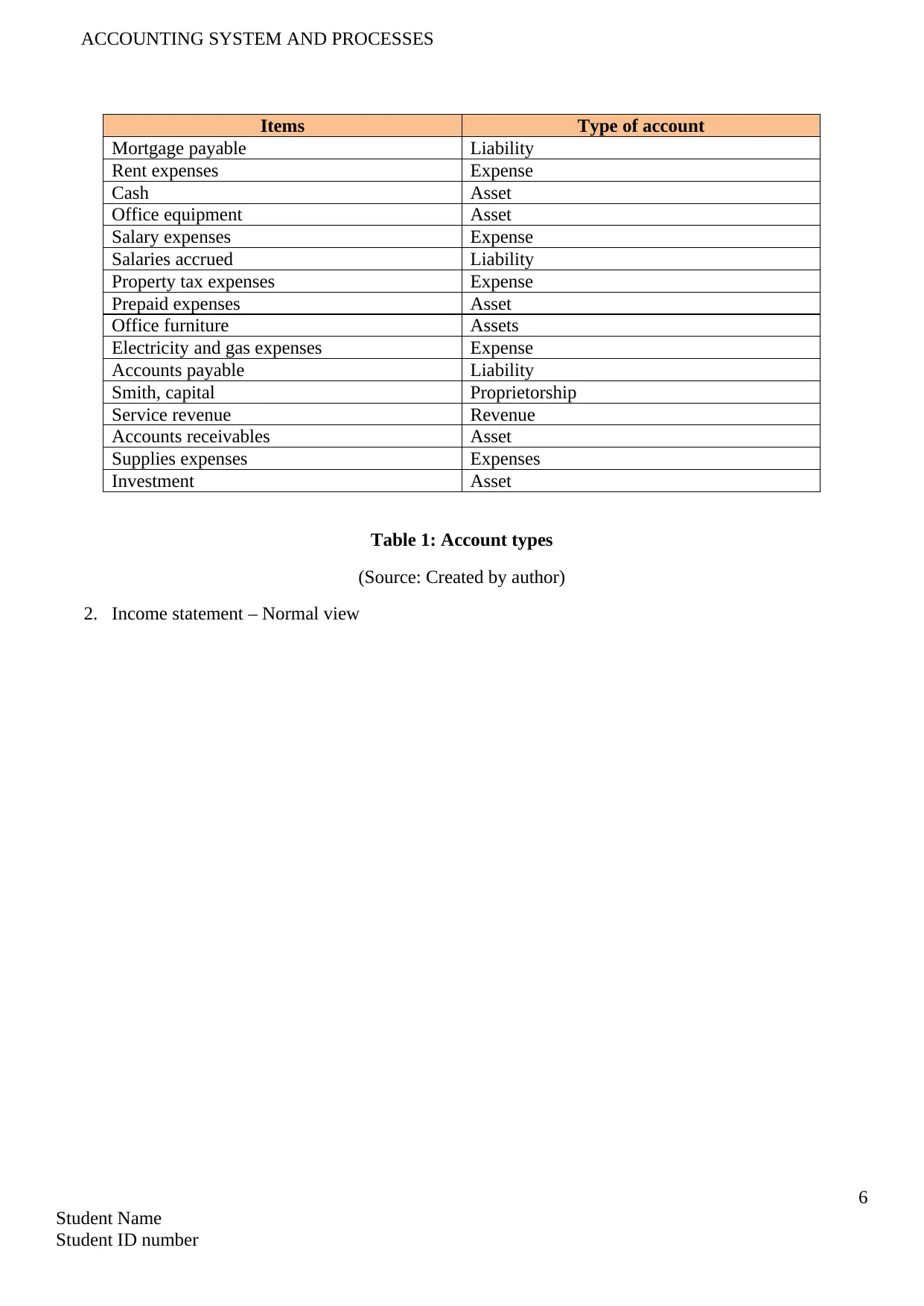
ACCOUNTING SYSTEM AND PROCESSES
Items Type of account
Mortgage payable Liability
Rent expenses Expense
Cash Asset
Office equipment Asset
Salary expenses Expense
Salaries accrued Liability
Property tax expenses Expense
Prepaid expenses Asset
Office furniture Assets
Electricity and gas expenses Expense
Accounts payable Liability
Smith, capital Proprietorship
Service revenue Revenue
Accounts receivables Asset
Supplies expenses Expenses
Investment Asset
Table 1: Account types
(Source: Created by author)
2. Income statement – Normal view
6
Student Name
Student ID number
Items Type of account
Mortgage payable Liability
Rent expenses Expense
Cash Asset
Office equipment Asset
Salary expenses Expense
Salaries accrued Liability
Property tax expenses Expense
Prepaid expenses Asset
Office furniture Assets
Electricity and gas expenses Expense
Accounts payable Liability
Smith, capital Proprietorship
Service revenue Revenue
Accounts receivables Asset
Supplies expenses Expenses
Investment Asset
Table 1: Account types
(Source: Created by author)
2. Income statement – Normal view
6
Student Name
Student ID number
Paraphrase This Document
Need a fresh take? Get an instant paraphrase of this document with our AI Paraphraser
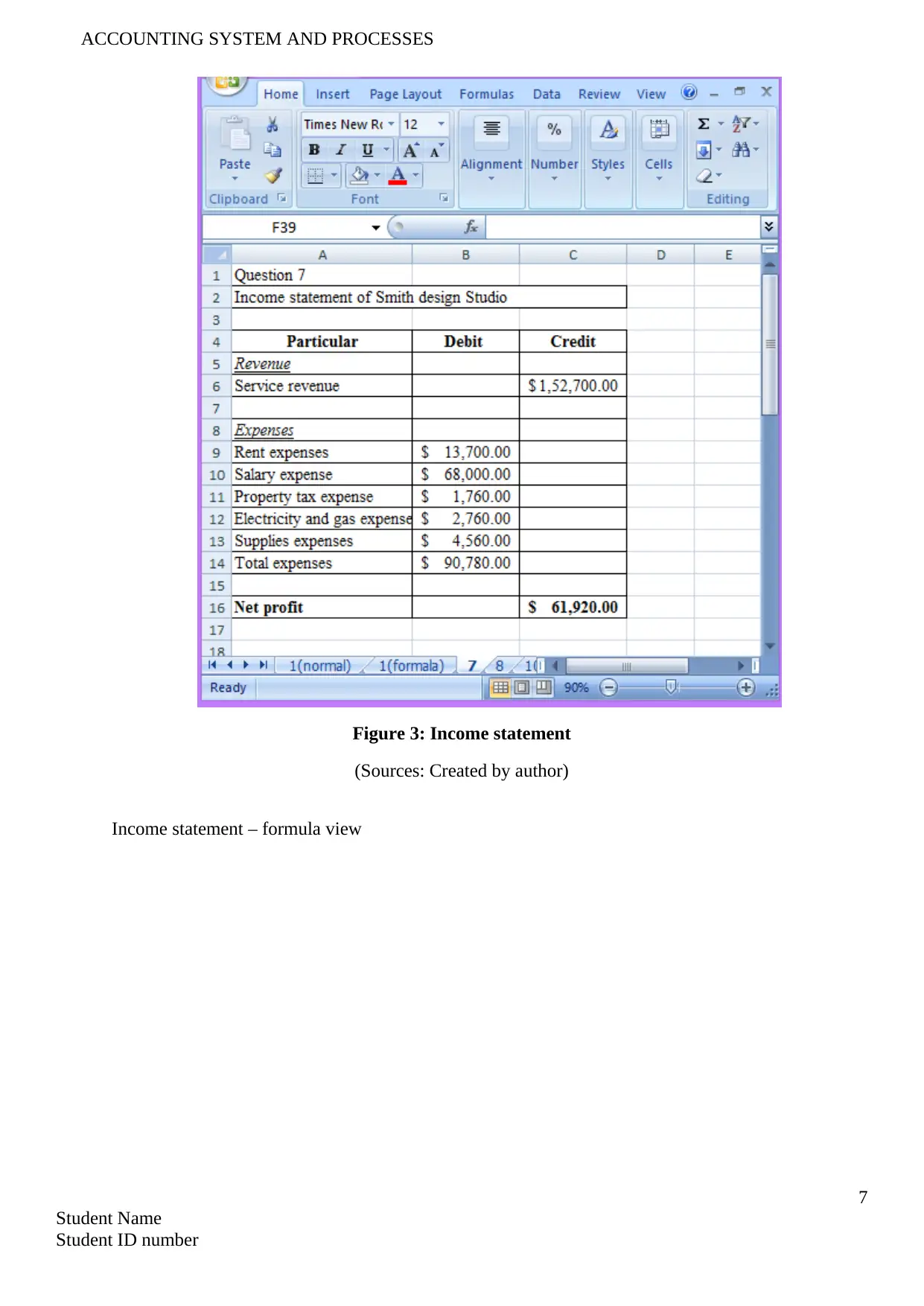
ACCOUNTING SYSTEM AND PROCESSES
Figure 3: Income statement
(Sources: Created by author)
Income statement – formula view
7
Student Name
Student ID number
Figure 3: Income statement
(Sources: Created by author)
Income statement – formula view
7
Student Name
Student ID number

ACCOUNTING SYSTEM AND PROCESSES
Figure 4: Income statement
(Sources: Created by author)
3. Amount of drawing = Nil
4. Balance sheet – normal view
8
Student Name
Student ID number
Figure 4: Income statement
(Sources: Created by author)
3. Amount of drawing = Nil
4. Balance sheet – normal view
8
Student Name
Student ID number
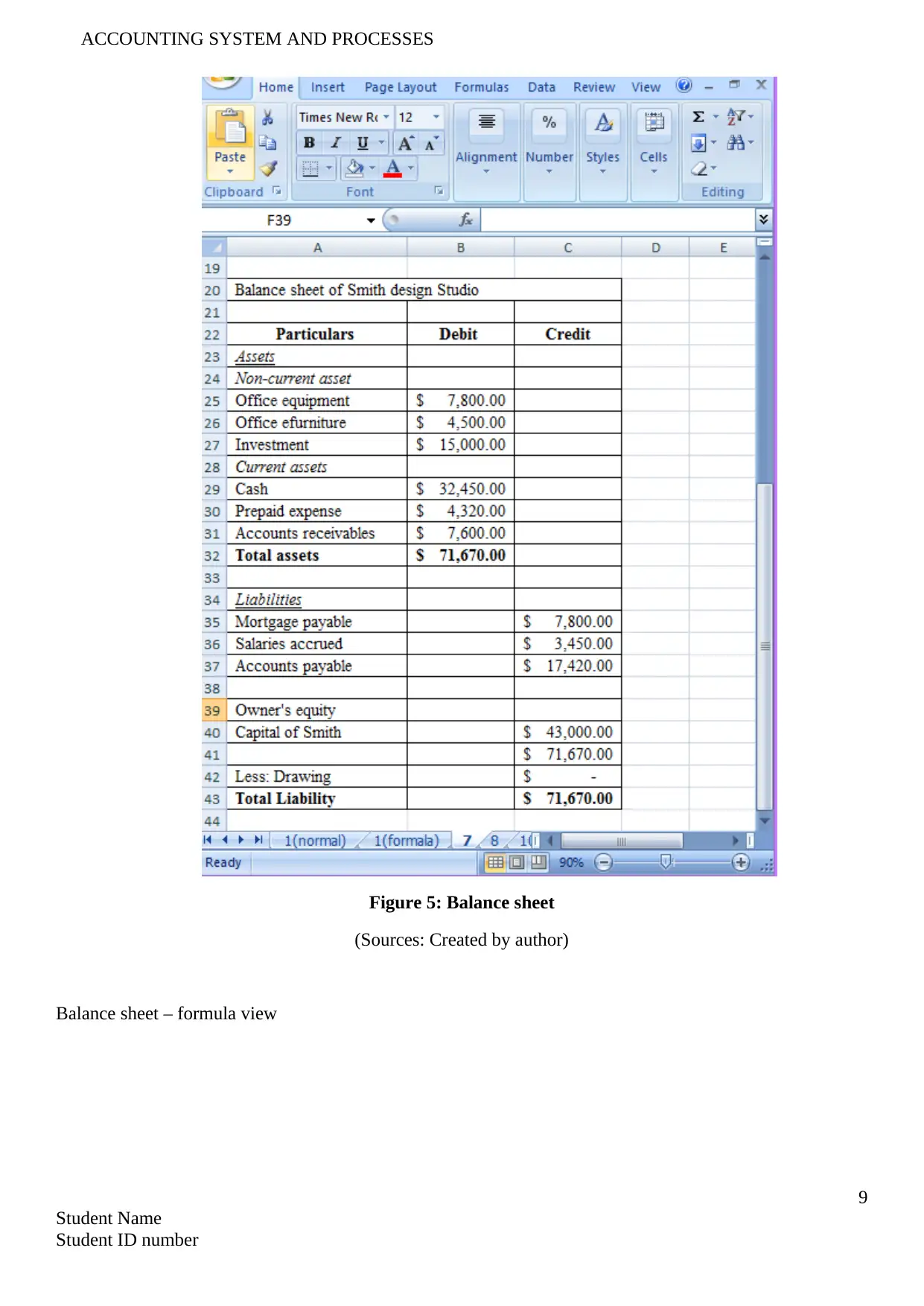
ACCOUNTING SYSTEM AND PROCESSES
Figure 5: Balance sheet
(Sources: Created by author)
Balance sheet – formula view
9
Student Name
Student ID number
Figure 5: Balance sheet
(Sources: Created by author)
Balance sheet – formula view
9
Student Name
Student ID number
Secure Best Marks with AI Grader
Need help grading? Try our AI Grader for instant feedback on your assignments.
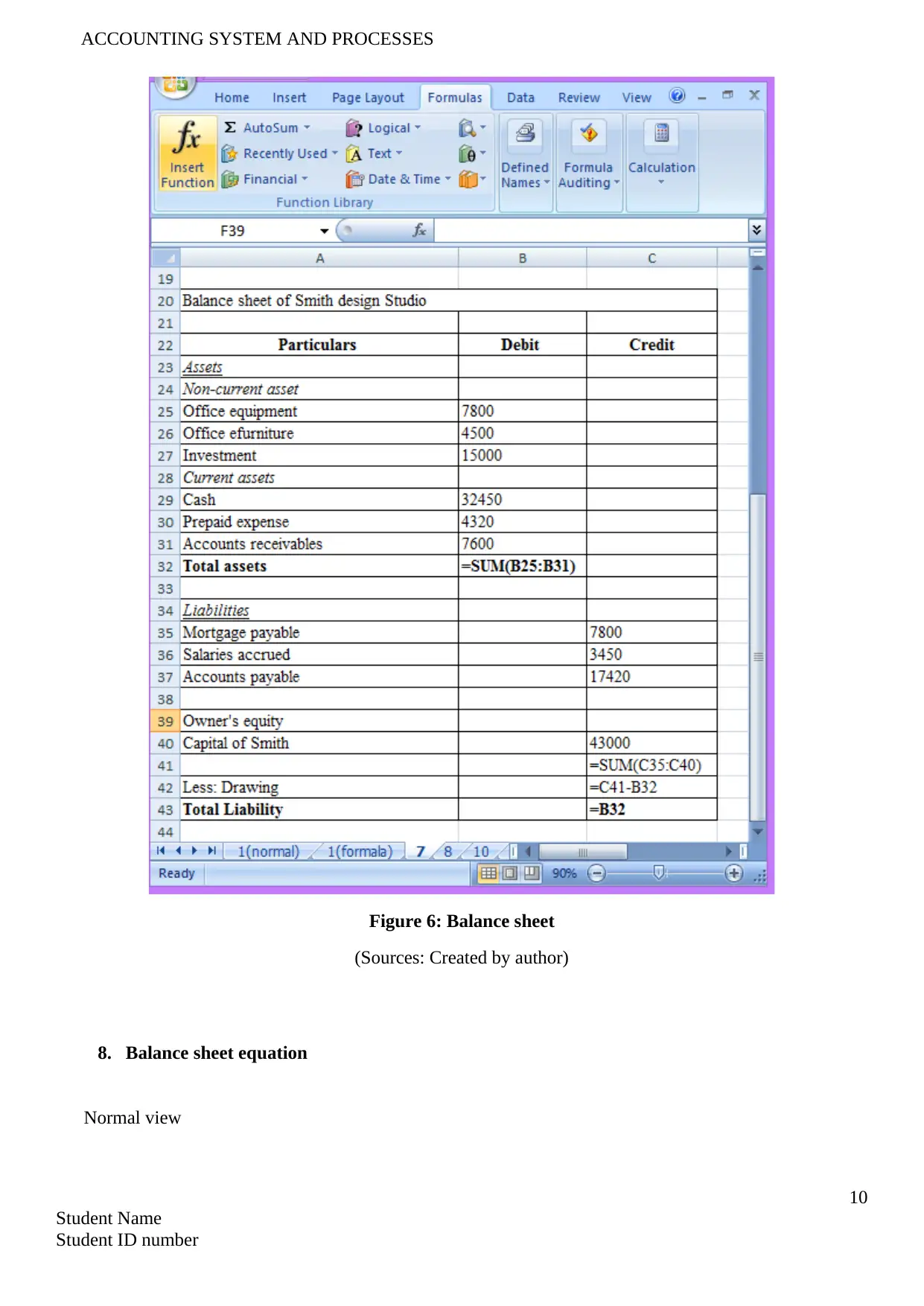
ACCOUNTING SYSTEM AND PROCESSES
Figure 6: Balance sheet
(Sources: Created by author)
8. Balance sheet equation
Normal view
10
Student Name
Student ID number
Figure 6: Balance sheet
(Sources: Created by author)
8. Balance sheet equation
Normal view
10
Student Name
Student ID number
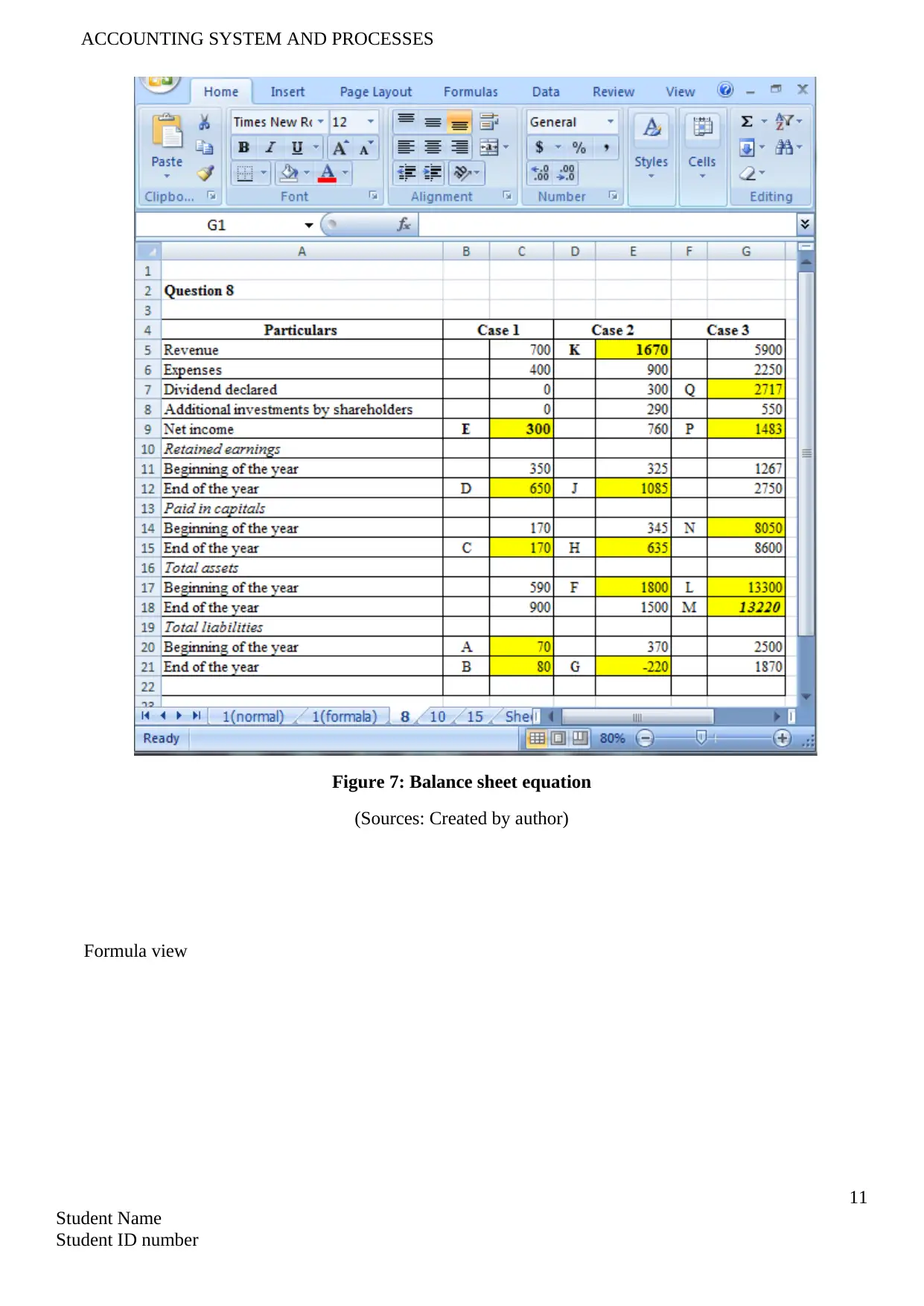
ACCOUNTING SYSTEM AND PROCESSES
Figure 7: Balance sheet equation
(Sources: Created by author)
Formula view
11
Student Name
Student ID number
Figure 7: Balance sheet equation
(Sources: Created by author)
Formula view
11
Student Name
Student ID number
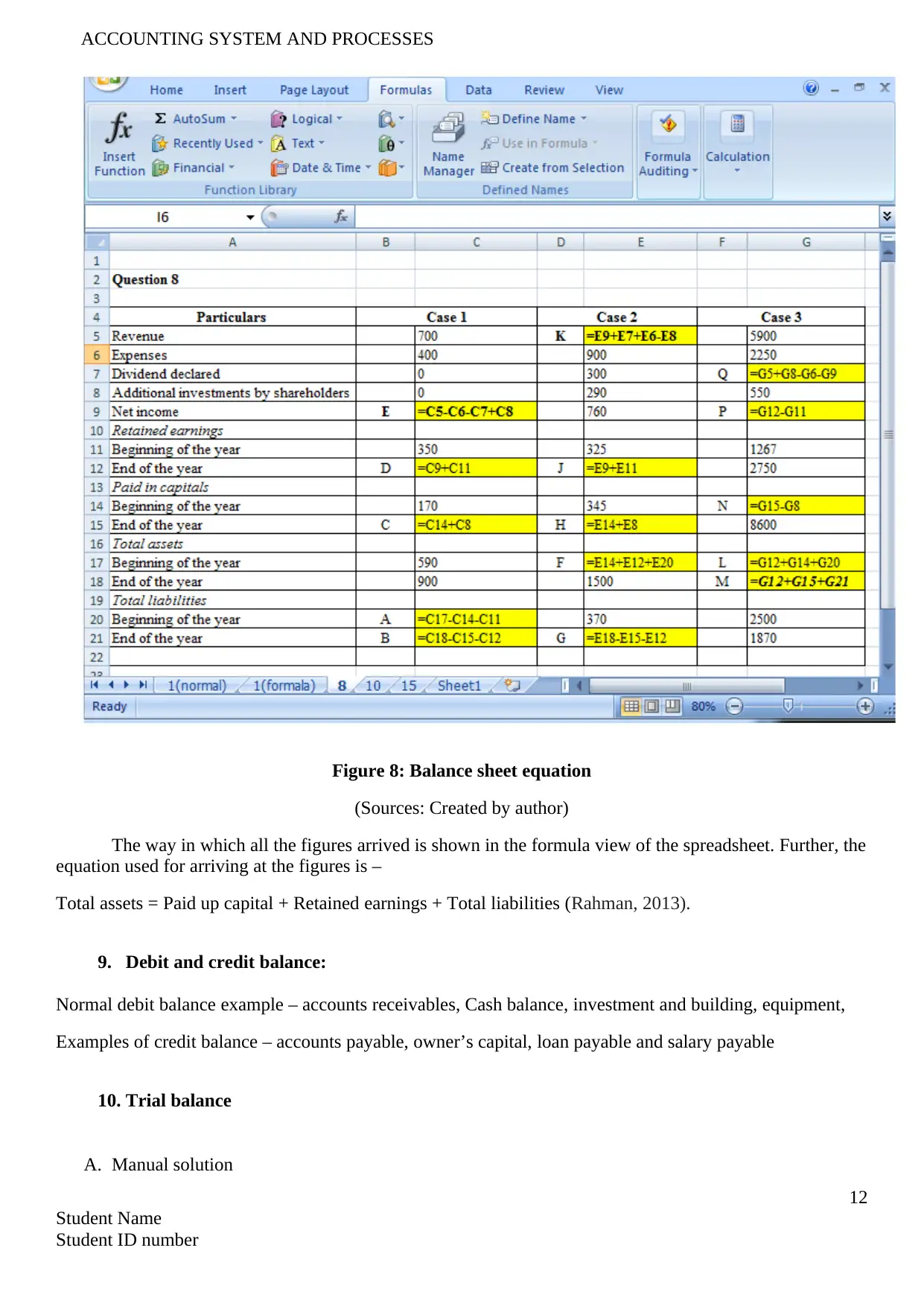
ACCOUNTING SYSTEM AND PROCESSES
Figure 8: Balance sheet equation
(Sources: Created by author)
The way in which all the figures arrived is shown in the formula view of the spreadsheet. Further, the
equation used for arriving at the figures is –
Total assets = Paid up capital + Retained earnings + Total liabilities (Rahman, 2013).
9. Debit and credit balance:
Normal debit balance example – accounts receivables, Cash balance, investment and building, equipment,
Examples of credit balance – accounts payable, owner’s capital, loan payable and salary payable
10. Trial balance
A. Manual solution
12
Student Name
Student ID number
Figure 8: Balance sheet equation
(Sources: Created by author)
The way in which all the figures arrived is shown in the formula view of the spreadsheet. Further, the
equation used for arriving at the figures is –
Total assets = Paid up capital + Retained earnings + Total liabilities (Rahman, 2013).
9. Debit and credit balance:
Normal debit balance example – accounts receivables, Cash balance, investment and building, equipment,
Examples of credit balance – accounts payable, owner’s capital, loan payable and salary payable
10. Trial balance
A. Manual solution
12
Student Name
Student ID number
Paraphrase This Document
Need a fresh take? Get an instant paraphrase of this document with our AI Paraphraser
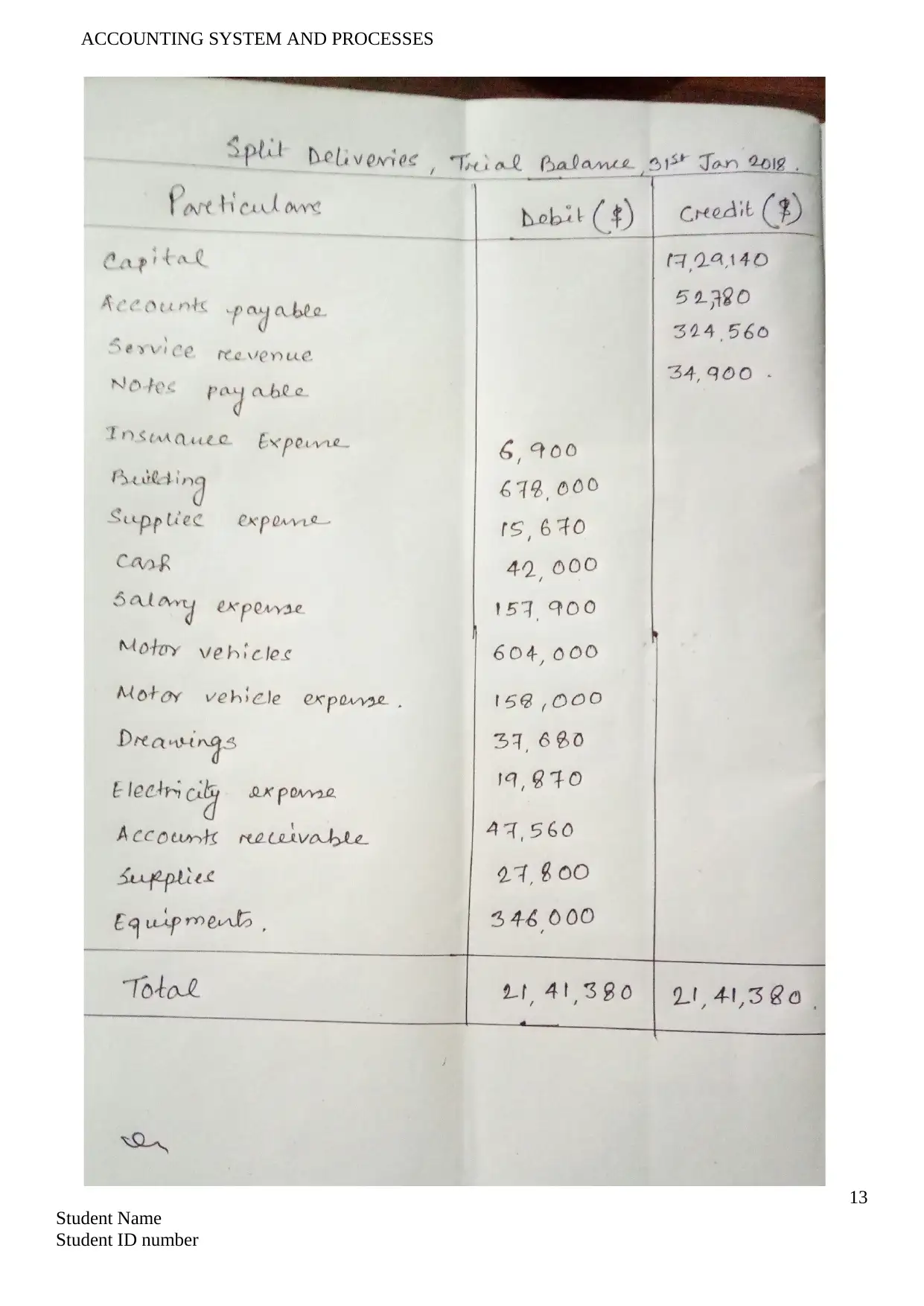
ACCOUNTING SYSTEM AND PROCESSES
13
Student Name
Student ID number
13
Student Name
Student ID number
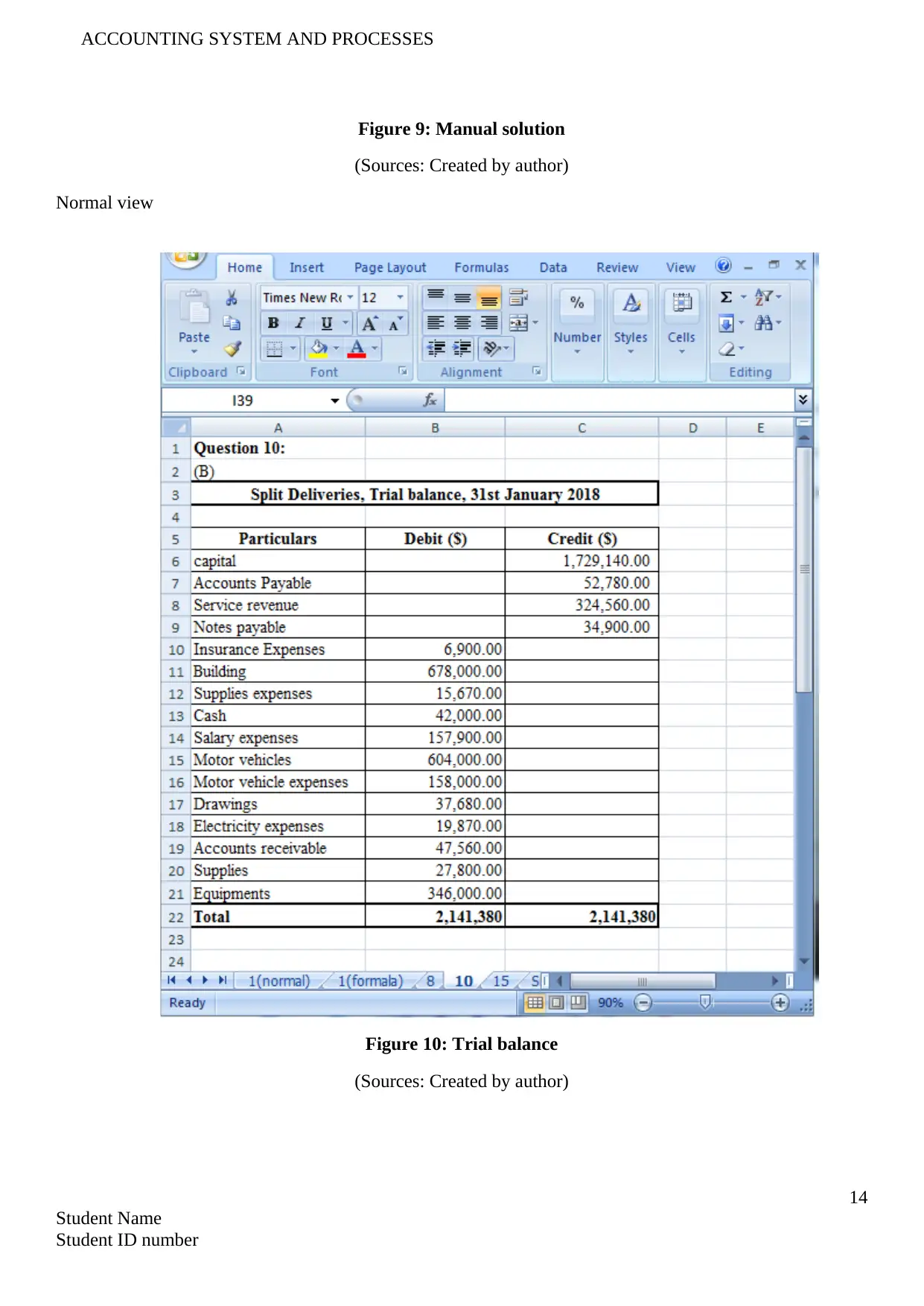
ACCOUNTING SYSTEM AND PROCESSES
Figure 9: Manual solution
(Sources: Created by author)
Normal view
Figure 10: Trial balance
(Sources: Created by author)
14
Student Name
Student ID number
Figure 9: Manual solution
(Sources: Created by author)
Normal view
Figure 10: Trial balance
(Sources: Created by author)
14
Student Name
Student ID number
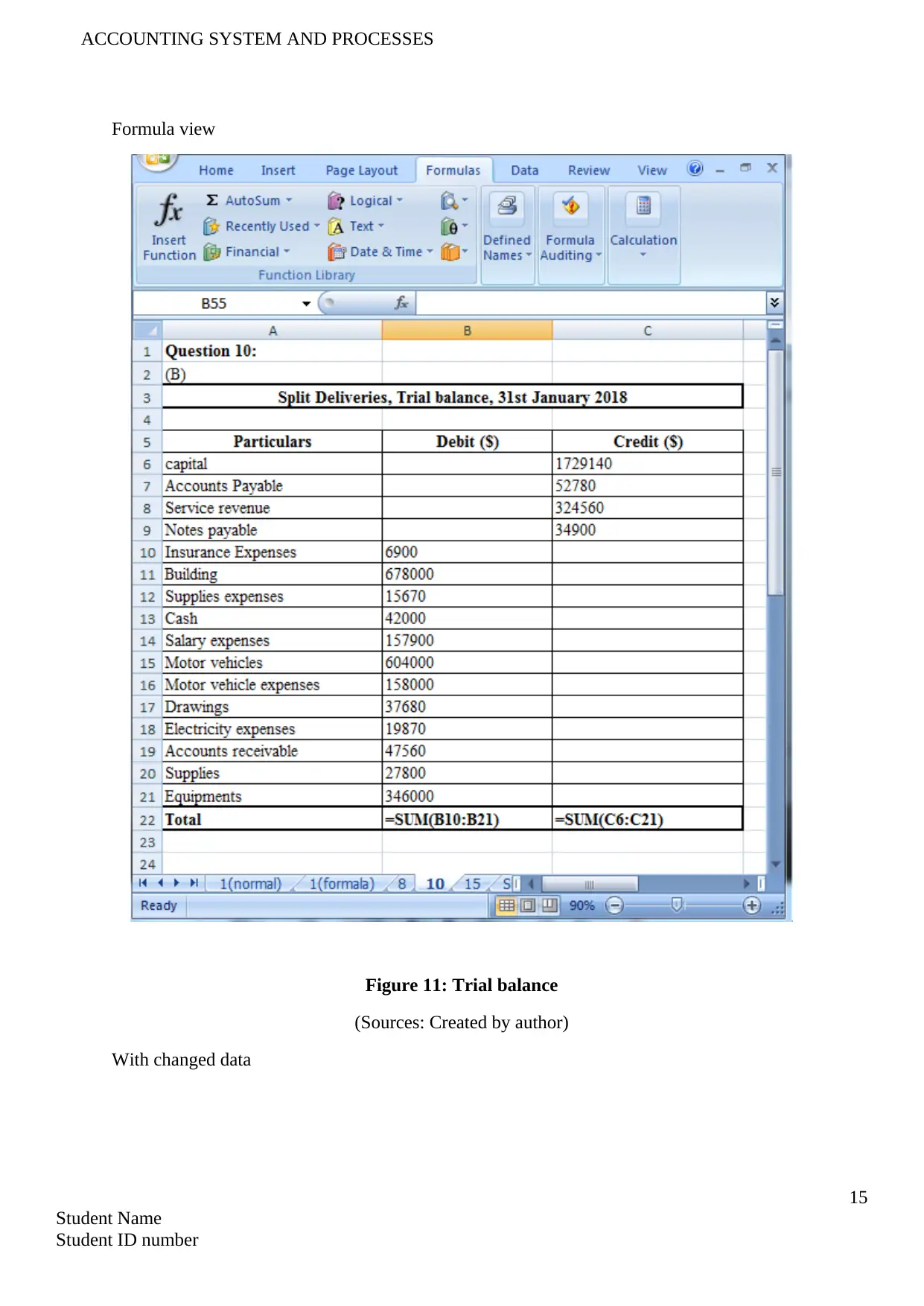
ACCOUNTING SYSTEM AND PROCESSES
Formula view
Figure 11: Trial balance
(Sources: Created by author)
With changed data
15
Student Name
Student ID number
Formula view
Figure 11: Trial balance
(Sources: Created by author)
With changed data
15
Student Name
Student ID number
Secure Best Marks with AI Grader
Need help grading? Try our AI Grader for instant feedback on your assignments.
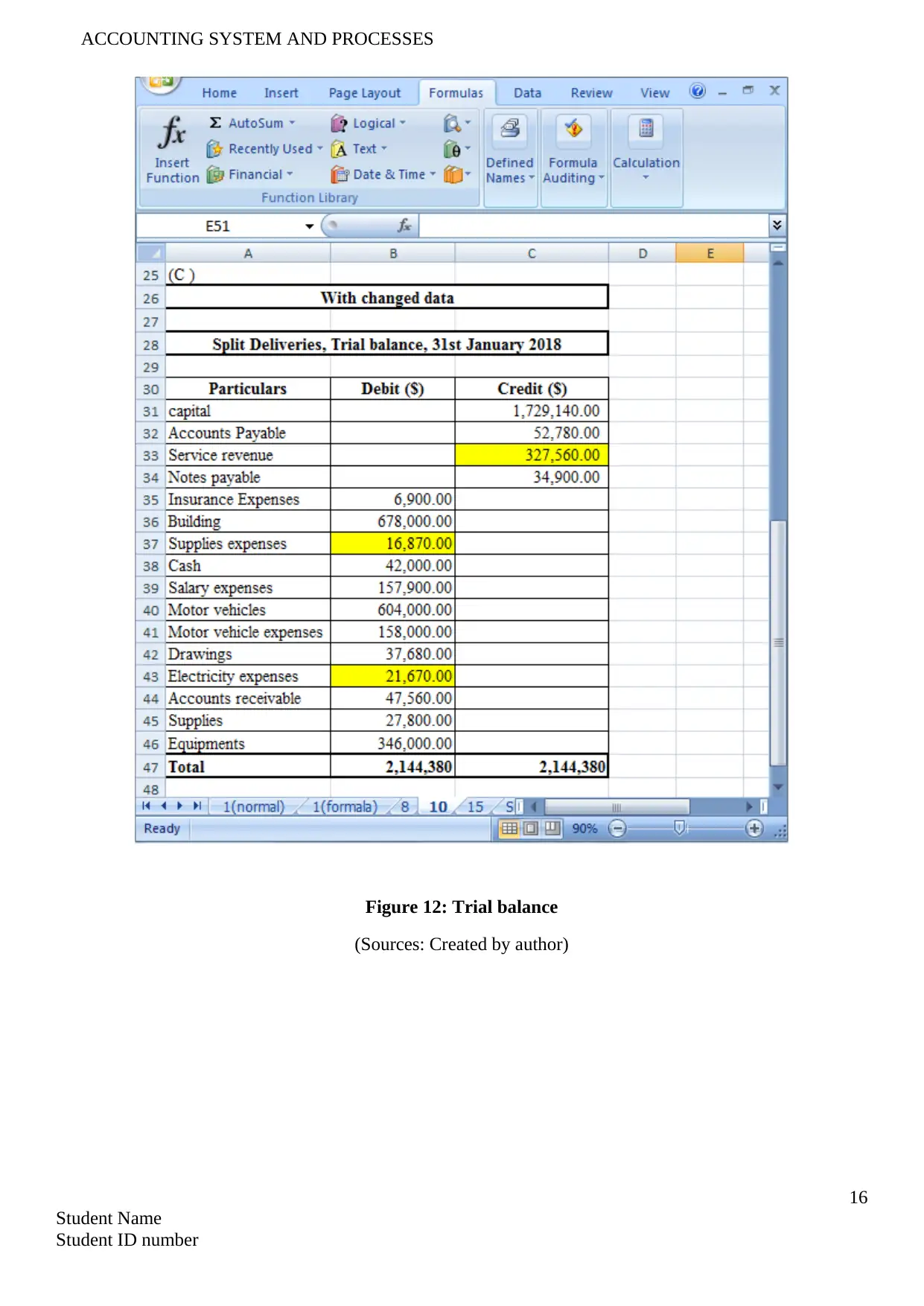
ACCOUNTING SYSTEM AND PROCESSES
Figure 12: Trial balance
(Sources: Created by author)
16
Student Name
Student ID number
Figure 12: Trial balance
(Sources: Created by author)
16
Student Name
Student ID number
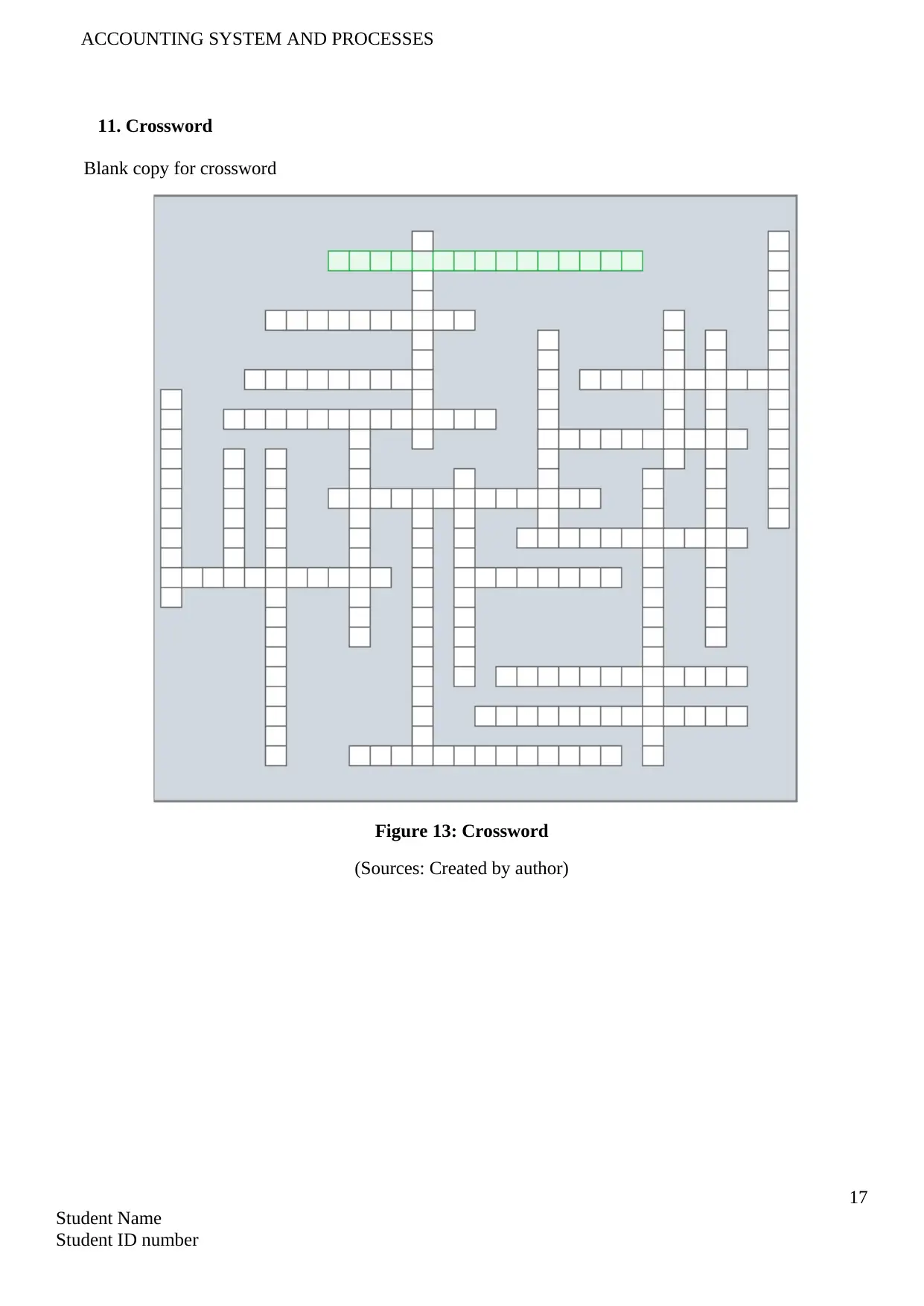
ACCOUNTING SYSTEM AND PROCESSES
11. Crossword
Blank copy for crossword
Figure 13: Crossword
(Sources: Created by author)
17
Student Name
Student ID number
11. Crossword
Blank copy for crossword
Figure 13: Crossword
(Sources: Created by author)
17
Student Name
Student ID number
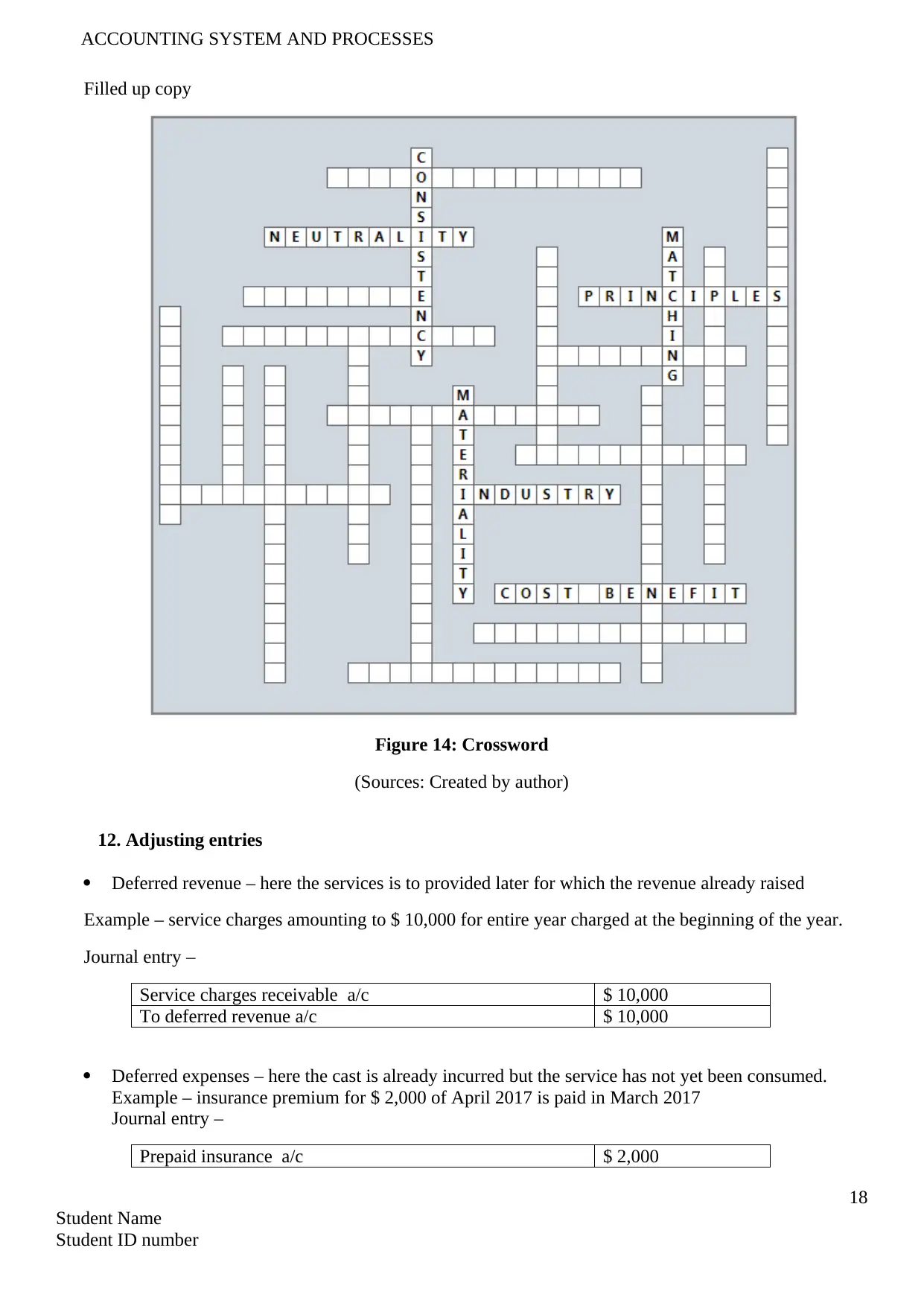
ACCOUNTING SYSTEM AND PROCESSES
Filled up copy
Figure 14: Crossword
(Sources: Created by author)
12. Adjusting entries
Deferred revenue – here the services is to provided later for which the revenue already raised
Example – service charges amounting to $ 10,000 for entire year charged at the beginning of the year.
Journal entry –
Service charges receivable a/c $ 10,000
To deferred revenue a/c $ 10,000
Deferred expenses – here the cast is already incurred but the service has not yet been consumed.
Example – insurance premium for $ 2,000 of April 2017 is paid in March 2017
Journal entry –
Prepaid insurance a/c $ 2,000
18
Student Name
Student ID number
Filled up copy
Figure 14: Crossword
(Sources: Created by author)
12. Adjusting entries
Deferred revenue – here the services is to provided later for which the revenue already raised
Example – service charges amounting to $ 10,000 for entire year charged at the beginning of the year.
Journal entry –
Service charges receivable a/c $ 10,000
To deferred revenue a/c $ 10,000
Deferred expenses – here the cast is already incurred but the service has not yet been consumed.
Example – insurance premium for $ 2,000 of April 2017 is paid in March 2017
Journal entry –
Prepaid insurance a/c $ 2,000
18
Student Name
Student ID number
Paraphrase This Document
Need a fresh take? Get an instant paraphrase of this document with our AI Paraphraser
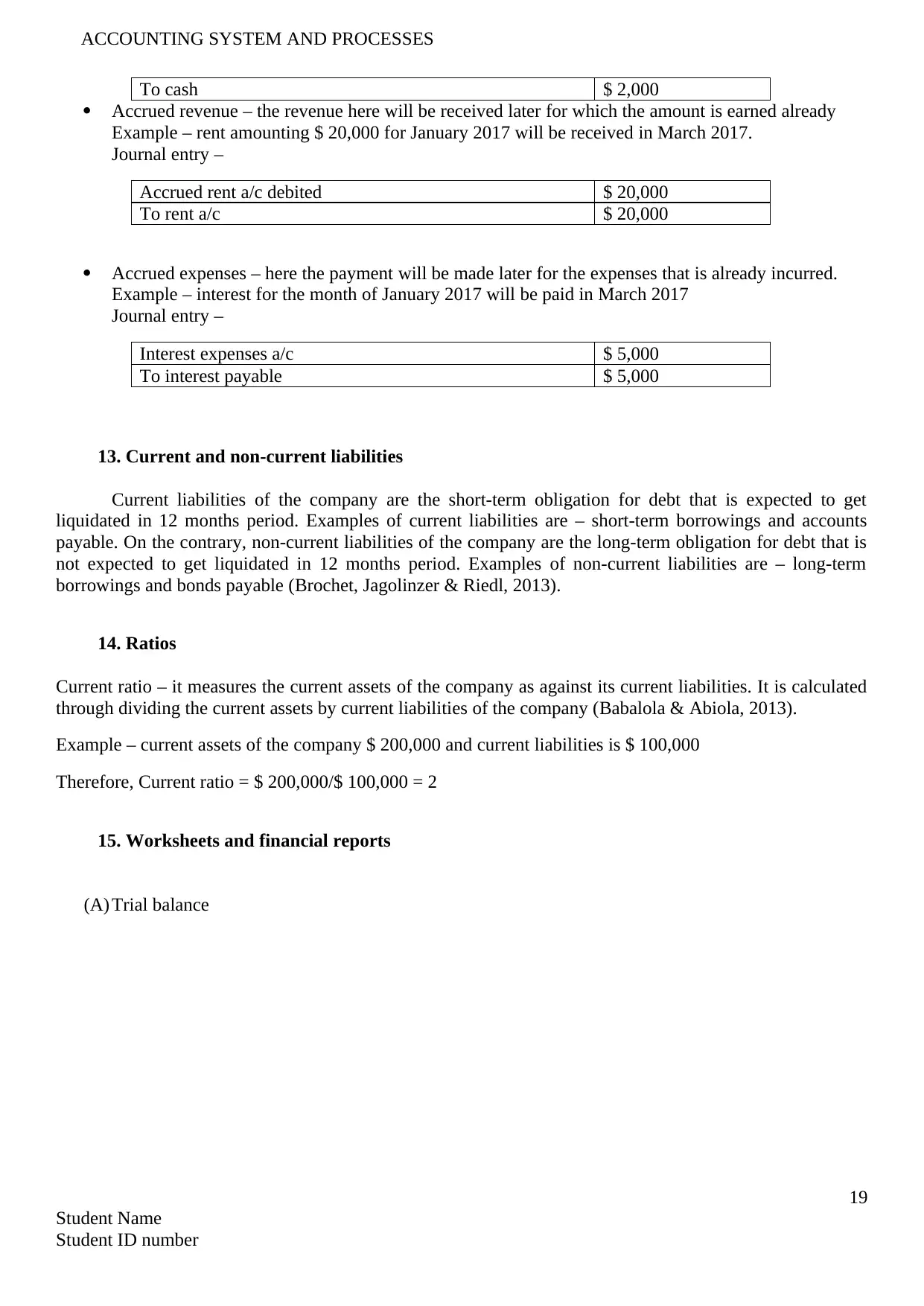
ACCOUNTING SYSTEM AND PROCESSES
To cash $ 2,000
Accrued revenue – the revenue here will be received later for which the amount is earned already
Example – rent amounting $ 20,000 for January 2017 will be received in March 2017.
Journal entry –
Accrued rent a/c debited $ 20,000
To rent a/c $ 20,000
Accrued expenses – here the payment will be made later for the expenses that is already incurred.
Example – interest for the month of January 2017 will be paid in March 2017
Journal entry –
Interest expenses a/c $ 5,000
To interest payable $ 5,000
13. Current and non-current liabilities
Current liabilities of the company are the short-term obligation for debt that is expected to get
liquidated in 12 months period. Examples of current liabilities are – short-term borrowings and accounts
payable. On the contrary, non-current liabilities of the company are the long-term obligation for debt that is
not expected to get liquidated in 12 months period. Examples of non-current liabilities are – long-term
borrowings and bonds payable (Brochet, Jagolinzer & Riedl, 2013).
14. Ratios
Current ratio – it measures the current assets of the company as against its current liabilities. It is calculated
through dividing the current assets by current liabilities of the company (Babalola & Abiola, 2013).
Example – current assets of the company $ 200,000 and current liabilities is $ 100,000
Therefore, Current ratio = $ 200,000/$ 100,000 = 2
15. Worksheets and financial reports
(A) Trial balance
19
Student Name
Student ID number
To cash $ 2,000
Accrued revenue – the revenue here will be received later for which the amount is earned already
Example – rent amounting $ 20,000 for January 2017 will be received in March 2017.
Journal entry –
Accrued rent a/c debited $ 20,000
To rent a/c $ 20,000
Accrued expenses – here the payment will be made later for the expenses that is already incurred.
Example – interest for the month of January 2017 will be paid in March 2017
Journal entry –
Interest expenses a/c $ 5,000
To interest payable $ 5,000
13. Current and non-current liabilities
Current liabilities of the company are the short-term obligation for debt that is expected to get
liquidated in 12 months period. Examples of current liabilities are – short-term borrowings and accounts
payable. On the contrary, non-current liabilities of the company are the long-term obligation for debt that is
not expected to get liquidated in 12 months period. Examples of non-current liabilities are – long-term
borrowings and bonds payable (Brochet, Jagolinzer & Riedl, 2013).
14. Ratios
Current ratio – it measures the current assets of the company as against its current liabilities. It is calculated
through dividing the current assets by current liabilities of the company (Babalola & Abiola, 2013).
Example – current assets of the company $ 200,000 and current liabilities is $ 100,000
Therefore, Current ratio = $ 200,000/$ 100,000 = 2
15. Worksheets and financial reports
(A) Trial balance
19
Student Name
Student ID number
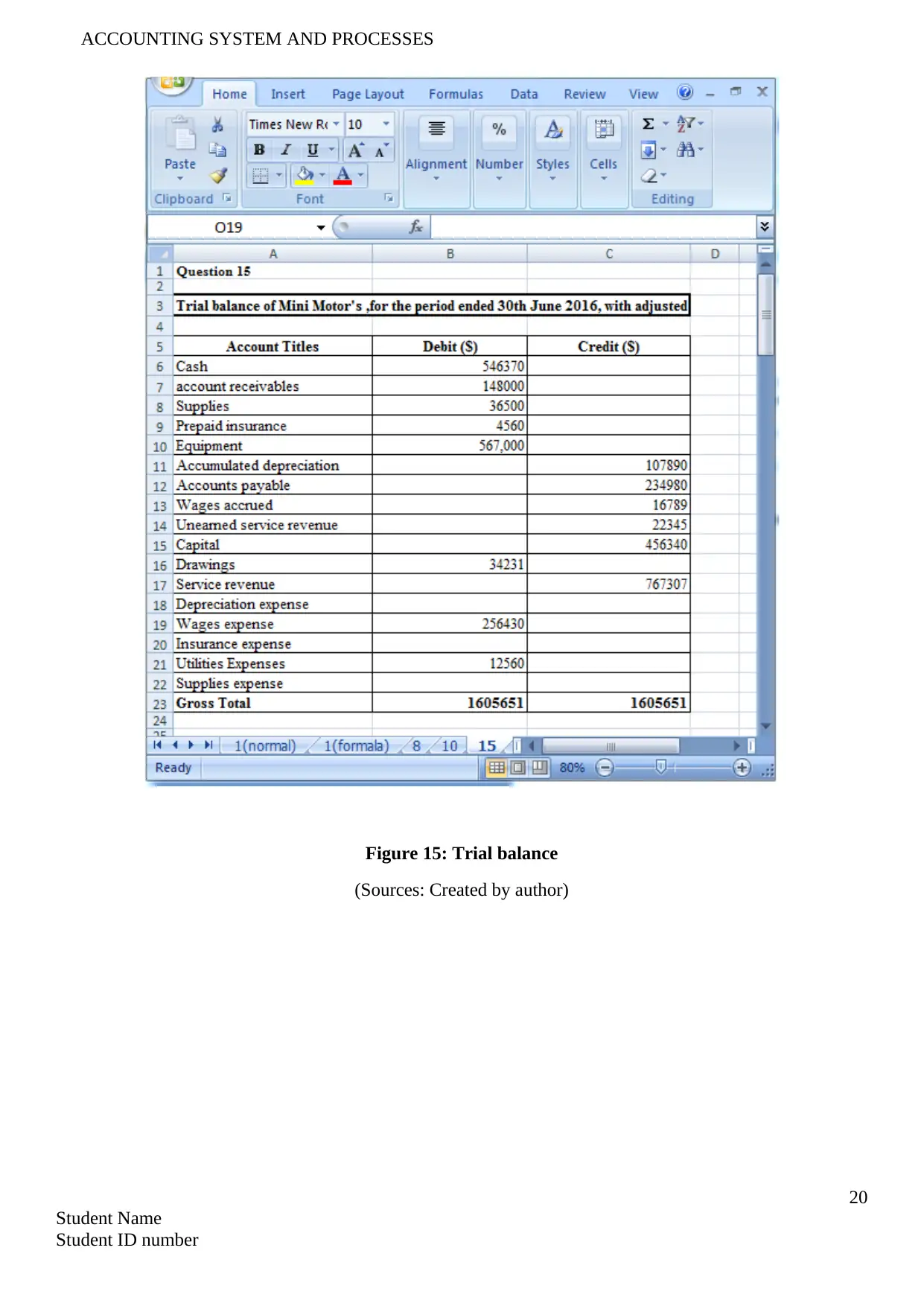
ACCOUNTING SYSTEM AND PROCESSES
Figure 15: Trial balance
(Sources: Created by author)
20
Student Name
Student ID number
Figure 15: Trial balance
(Sources: Created by author)
20
Student Name
Student ID number
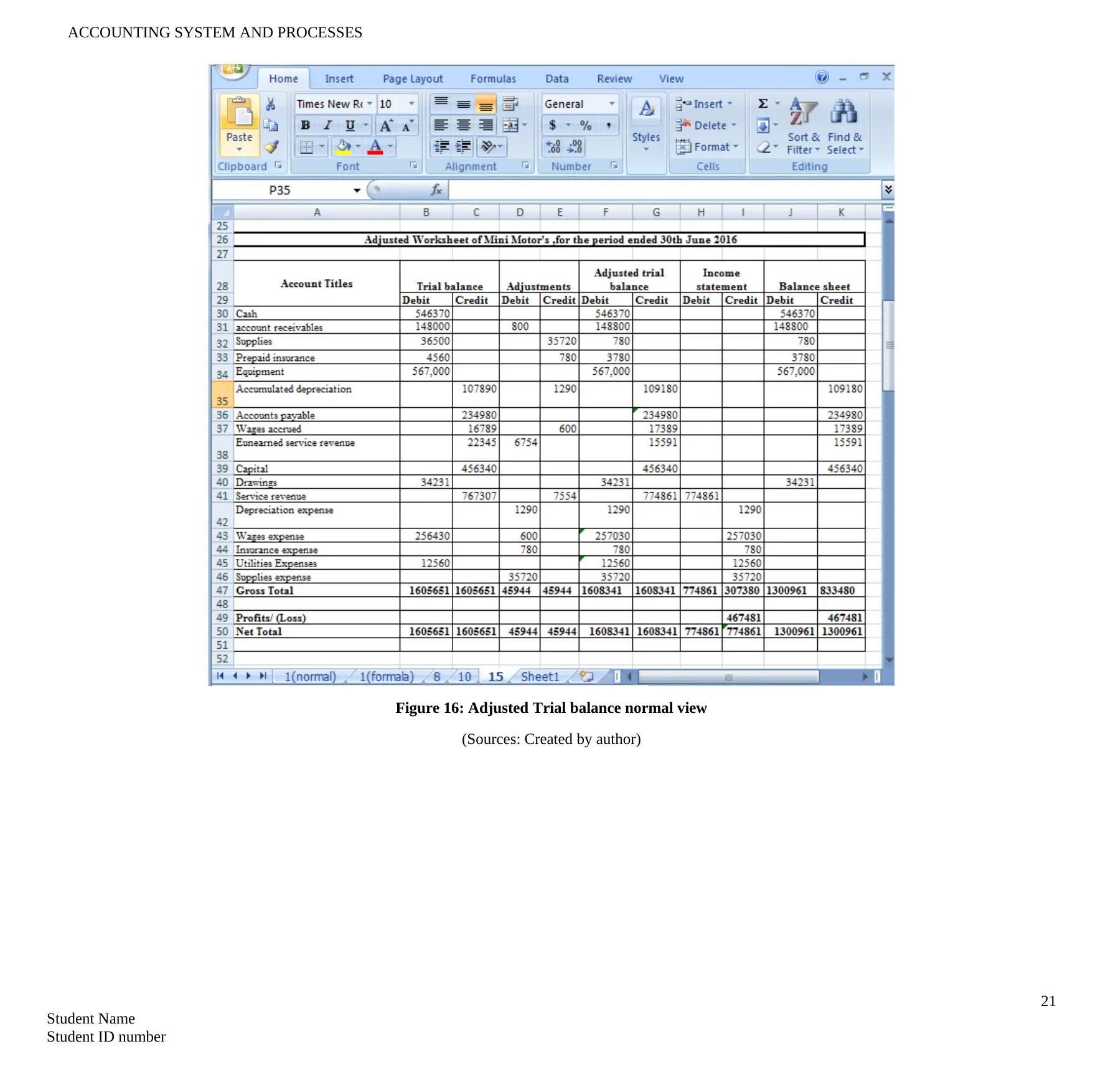
ACCOUNTING SYSTEM AND PROCESSES
Figure 16: Adjusted Trial balance normal view
(Sources: Created by author)
21
Student Name
Student ID number
Figure 16: Adjusted Trial balance normal view
(Sources: Created by author)
21
Student Name
Student ID number
Secure Best Marks with AI Grader
Need help grading? Try our AI Grader for instant feedback on your assignments.
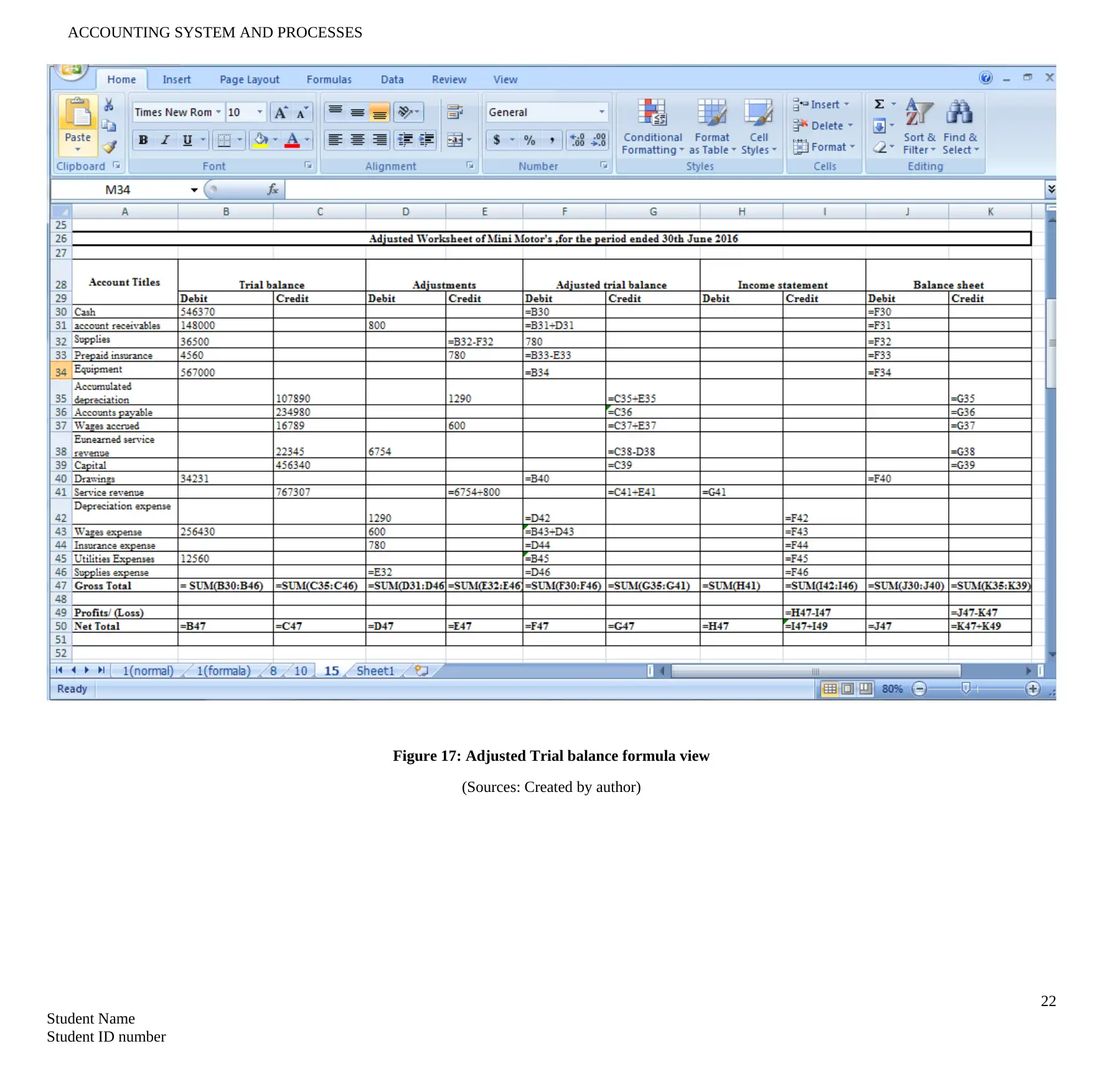
ACCOUNTING SYSTEM AND PROCESSES
Figure 17: Adjusted Trial balance formula view
(Sources: Created by author)
22
Student Name
Student ID number
Figure 17: Adjusted Trial balance formula view
(Sources: Created by author)
22
Student Name
Student ID number
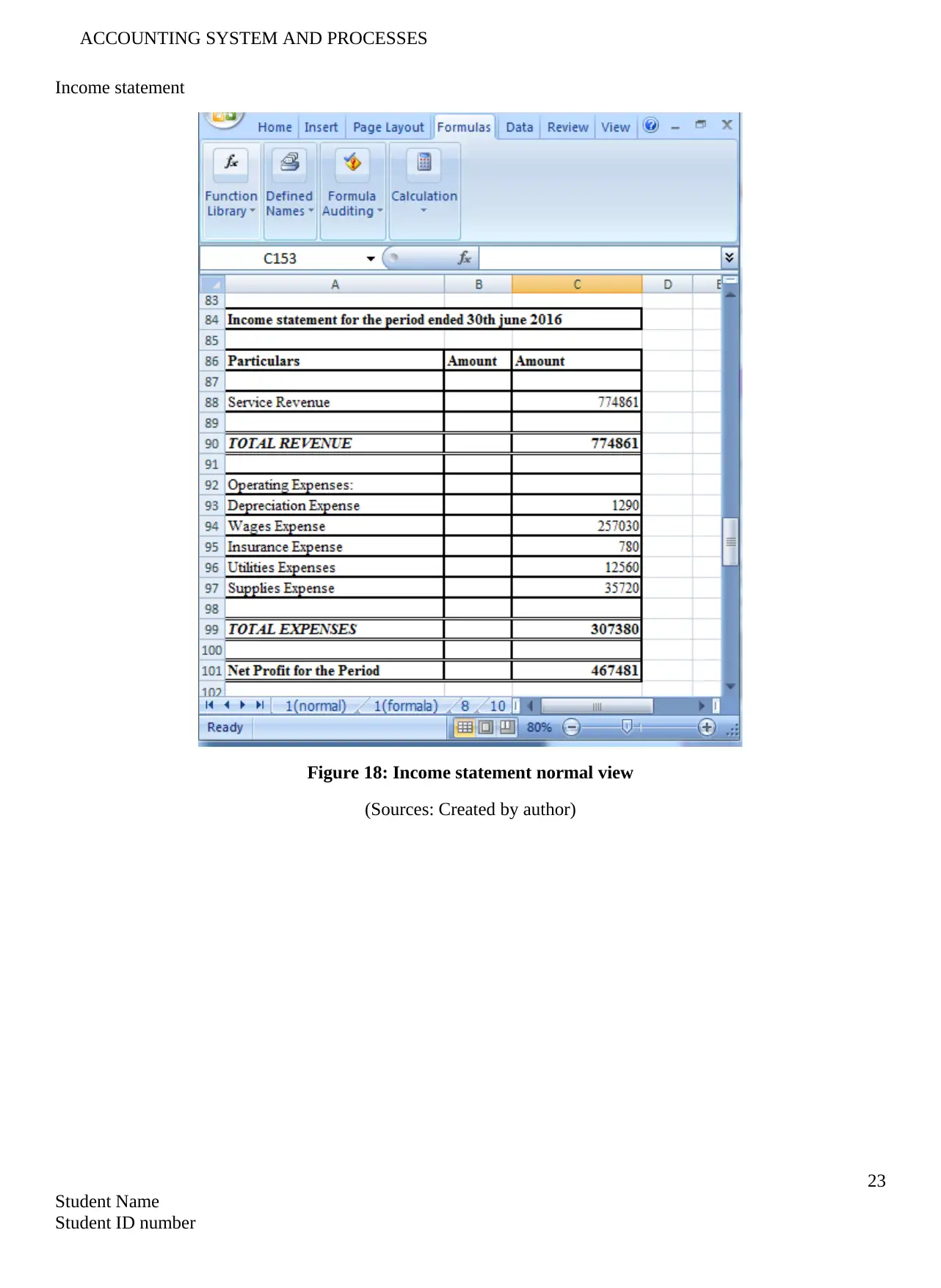
ACCOUNTING SYSTEM AND PROCESSES
Income statement
Figure 18: Income statement normal view
(Sources: Created by author)
23
Student Name
Student ID number
Income statement
Figure 18: Income statement normal view
(Sources: Created by author)
23
Student Name
Student ID number
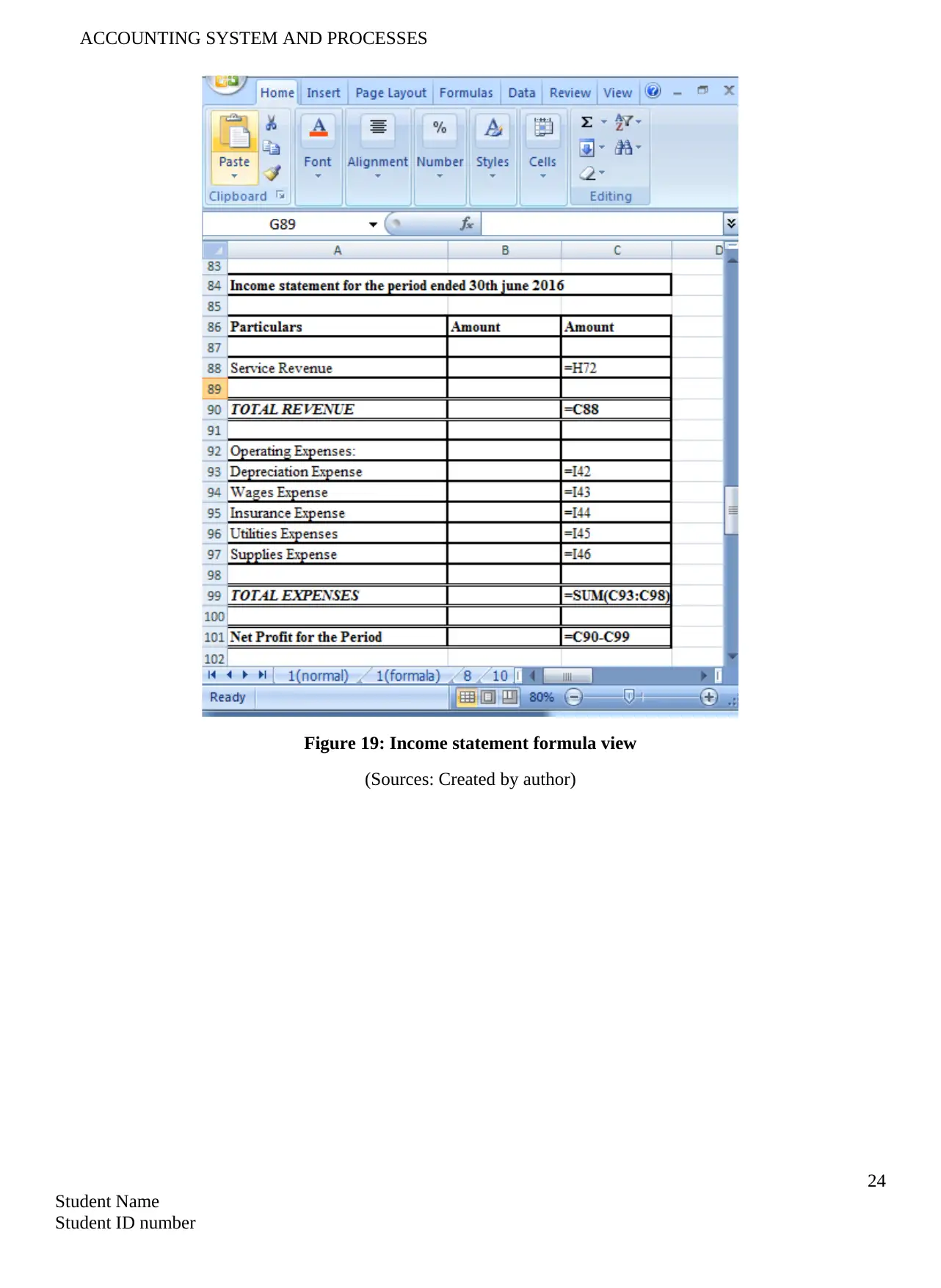
ACCOUNTING SYSTEM AND PROCESSES
Figure 19: Income statement formula view
(Sources: Created by author)
24
Student Name
Student ID number
Figure 19: Income statement formula view
(Sources: Created by author)
24
Student Name
Student ID number
Paraphrase This Document
Need a fresh take? Get an instant paraphrase of this document with our AI Paraphraser
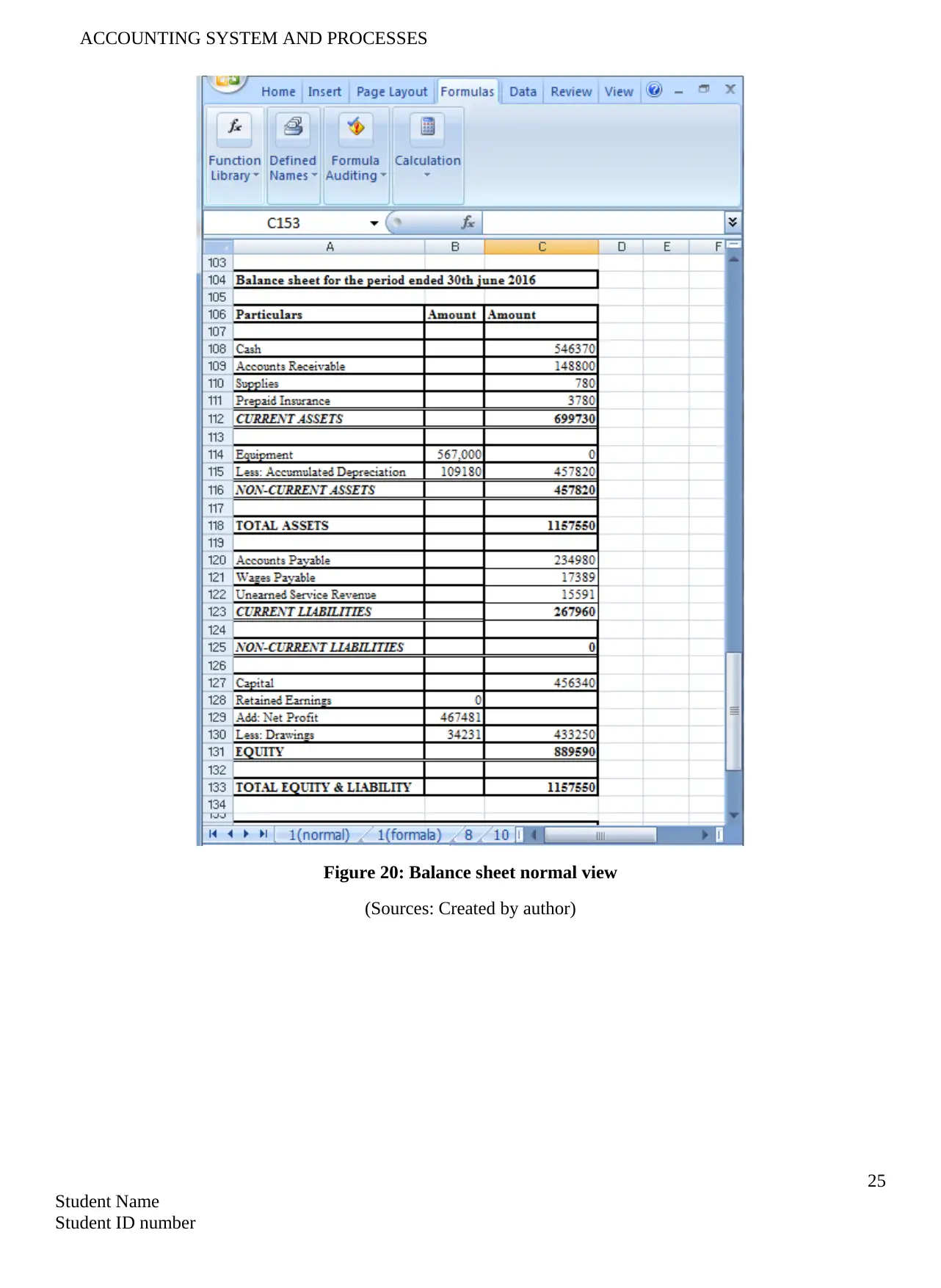
ACCOUNTING SYSTEM AND PROCESSES
Figure 20: Balance sheet normal view
(Sources: Created by author)
25
Student Name
Student ID number
Figure 20: Balance sheet normal view
(Sources: Created by author)
25
Student Name
Student ID number
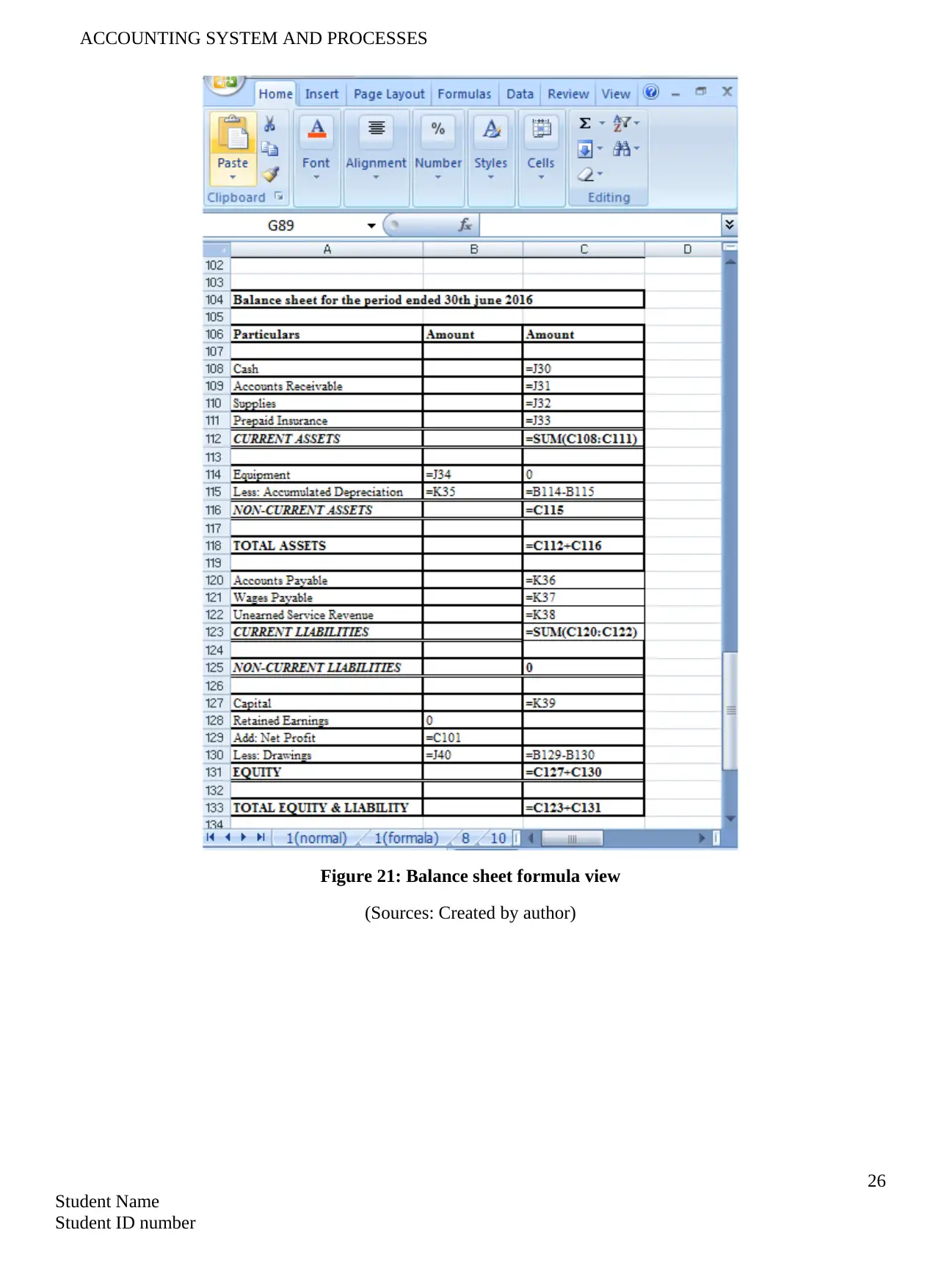
ACCOUNTING SYSTEM AND PROCESSES
Figure 21: Balance sheet formula view
(Sources: Created by author)
26
Student Name
Student ID number
Figure 21: Balance sheet formula view
(Sources: Created by author)
26
Student Name
Student ID number

ACCOUNTING SYSTEM AND PROCESSES
Figure 22: Changes in equity normal view
(Sources: Created by author)
Figure 23: Changes in equity formula view
(Sources: Created by author)
27
Student Name
Student ID number
Figure 22: Changes in equity normal view
(Sources: Created by author)
Figure 23: Changes in equity formula view
(Sources: Created by author)
27
Student Name
Student ID number
Secure Best Marks with AI Grader
Need help grading? Try our AI Grader for instant feedback on your assignments.
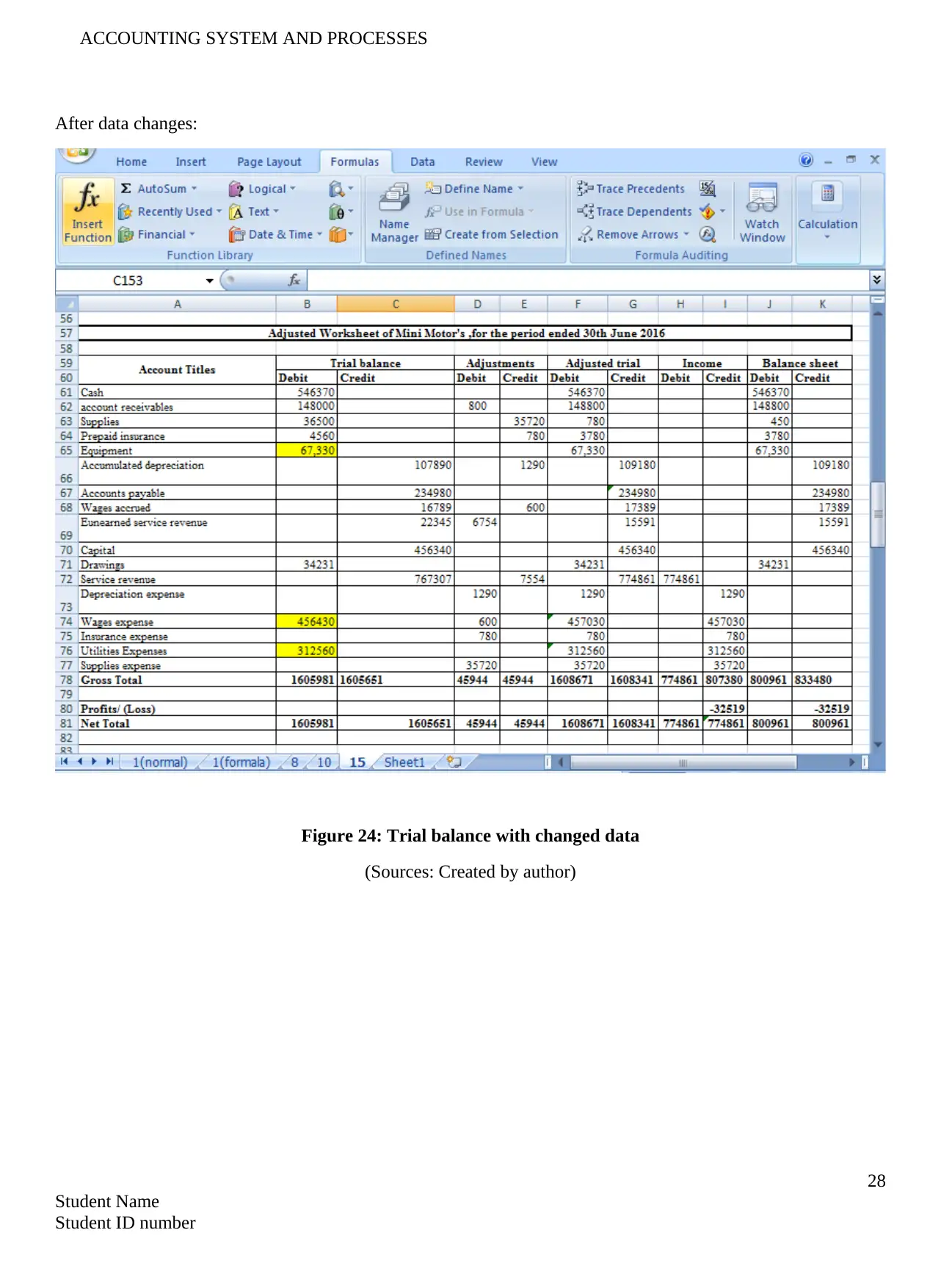
ACCOUNTING SYSTEM AND PROCESSES
After data changes:
Figure 24: Trial balance with changed data
(Sources: Created by author)
28
Student Name
Student ID number
After data changes:
Figure 24: Trial balance with changed data
(Sources: Created by author)
28
Student Name
Student ID number

ACCOUNTING SYSTEM AND PROCESSES
References:
ABC Learning collapse case study. (2018). Cpaaustralia.com.au. Retrieved 20 March 2018, from
https://www.cpaaustralia.com.au/professional-resources/education/abc-learning-collapse-case-study
Babalola, Y. A., & Abiola, F. R. (2013). Financial ratio analysis of firms: A tool for decision
making. International journal of management sciences, 1(4), 132-137.
Bawankule, K. L. (2015). Design and implementation of massive MYSQL data intelligent export system to
excel by using Apache-POI libraries. International Journal of Computer Science and Network Security
(IJCSNS), 15(9), 85.
Brigham, E. F., & Ehrhardt, M. C. (2013). Financial management: Theory & practice. Cengage Learning.
Brochet, F., Jagolinzer, A. D., & Riedl, E. J. (2013). Mandatory IFRS adoption and financial statement
comparability. Contemporary Accounting Research, 30(4), 1373-1400.
Dalnial, H., Kamaluddin, A., Sanusi, Z. M., & Khairuddin, K. S. (2014). Detecting fraudulent financial reporting
through financial statement analysis. Journal of Advanced Management Science, 2(1).
Ferro, M. J., & Martins, H. F. (2016). Academic plagiarism: yielding to temptation. British Journal of
Education, Society & Behavioural Science, 13(1), 1-11.
Kim, M., Batchu, S. K., & Sirota, J. (2016). U.S. Patent No. 9,235,717. Washington, DC: U.S. Patent and
Trademark Office.
Lin, C. C., Chiu, A. A., Huang, S. Y., & Yen, D. C. (2015). Detecting the financial statement fraud: The analysis
of the differences between data mining techniques and experts’ judgments. Knowledge-Based
Systems, 89, 459-470.
Rahman, A. R. (2013). The Australian Accounting Standards Review Board (RLE Accounting): The
Establishment of Its Participative Review Process. Routledge.
Walker, J. S., Tulley, S. C., Jorasch, J. A., Sammon, R. P., & Gelman, G. M. (2016). U.S. Patent Application
No. 14/992,770.
29
Student Name
Student ID number
References:
ABC Learning collapse case study. (2018). Cpaaustralia.com.au. Retrieved 20 March 2018, from
https://www.cpaaustralia.com.au/professional-resources/education/abc-learning-collapse-case-study
Babalola, Y. A., & Abiola, F. R. (2013). Financial ratio analysis of firms: A tool for decision
making. International journal of management sciences, 1(4), 132-137.
Bawankule, K. L. (2015). Design and implementation of massive MYSQL data intelligent export system to
excel by using Apache-POI libraries. International Journal of Computer Science and Network Security
(IJCSNS), 15(9), 85.
Brigham, E. F., & Ehrhardt, M. C. (2013). Financial management: Theory & practice. Cengage Learning.
Brochet, F., Jagolinzer, A. D., & Riedl, E. J. (2013). Mandatory IFRS adoption and financial statement
comparability. Contemporary Accounting Research, 30(4), 1373-1400.
Dalnial, H., Kamaluddin, A., Sanusi, Z. M., & Khairuddin, K. S. (2014). Detecting fraudulent financial reporting
through financial statement analysis. Journal of Advanced Management Science, 2(1).
Ferro, M. J., & Martins, H. F. (2016). Academic plagiarism: yielding to temptation. British Journal of
Education, Society & Behavioural Science, 13(1), 1-11.
Kim, M., Batchu, S. K., & Sirota, J. (2016). U.S. Patent No. 9,235,717. Washington, DC: U.S. Patent and
Trademark Office.
Lin, C. C., Chiu, A. A., Huang, S. Y., & Yen, D. C. (2015). Detecting the financial statement fraud: The analysis
of the differences between data mining techniques and experts’ judgments. Knowledge-Based
Systems, 89, 459-470.
Rahman, A. R. (2013). The Australian Accounting Standards Review Board (RLE Accounting): The
Establishment of Its Participative Review Process. Routledge.
Walker, J. S., Tulley, S. C., Jorasch, J. A., Sammon, R. P., & Gelman, G. M. (2016). U.S. Patent Application
No. 14/992,770.
29
Student Name
Student ID number
1 out of 30
Related Documents
Your All-in-One AI-Powered Toolkit for Academic Success.
+13062052269
info@desklib.com
Available 24*7 on WhatsApp / Email
![[object Object]](/_next/static/media/star-bottom.7253800d.svg)
Unlock your academic potential
© 2024 | Zucol Services PVT LTD | All rights reserved.





